Reference management. Clean and simple.

How to write a thesis statement + examples

What is a thesis statement?
Is a thesis statement a question, how do you write a good thesis statement, how do i know if my thesis statement is good, examples of thesis statements, helpful resources on how to write a thesis statement, frequently asked questions about writing a thesis statement, related articles.
A thesis statement is the main argument of your paper or thesis.
The thesis statement is one of the most important elements of any piece of academic writing . It is a brief statement of your paper’s main argument. Essentially, you are stating what you will be writing about.
You can see your thesis statement as an answer to a question. While it also contains the question, it should really give an answer to the question with new information and not just restate or reiterate it.
Your thesis statement is part of your introduction. Learn more about how to write a good thesis introduction in our introduction guide .
A thesis statement is not a question. A statement must be arguable and provable through evidence and analysis. While your thesis might stem from a research question, it should be in the form of a statement.
Tip: A thesis statement is typically 1-2 sentences. For a longer project like a thesis, the statement may be several sentences or a paragraph.
A good thesis statement needs to do the following:
- Condense the main idea of your thesis into one or two sentences.
- Answer your project’s main research question.
- Clearly state your position in relation to the topic .
- Make an argument that requires support or evidence.
Once you have written down a thesis statement, check if it fulfills the following criteria:
- Your statement needs to be provable by evidence. As an argument, a thesis statement needs to be debatable.
- Your statement needs to be precise. Do not give away too much information in the thesis statement and do not load it with unnecessary information.
- Your statement cannot say that one solution is simply right or simply wrong as a matter of fact. You should draw upon verified facts to persuade the reader of your solution, but you cannot just declare something as right or wrong.
As previously mentioned, your thesis statement should answer a question.
If the question is:
What do you think the City of New York should do to reduce traffic congestion?
A good thesis statement restates the question and answers it:
In this paper, I will argue that the City of New York should focus on providing exclusive lanes for public transport and adaptive traffic signals to reduce traffic congestion by the year 2035.
Here is another example. If the question is:
How can we end poverty?
A good thesis statement should give more than one solution to the problem in question:
In this paper, I will argue that introducing universal basic income can help reduce poverty and positively impact the way we work.
- The Writing Center of the University of North Carolina has a list of questions to ask to see if your thesis is strong .
A thesis statement is part of the introduction of your paper. It is usually found in the first or second paragraph to let the reader know your research purpose from the beginning.
In general, a thesis statement should have one or two sentences. But the length really depends on the overall length of your project. Take a look at our guide about the length of thesis statements for more insight on this topic.
Here is a list of Thesis Statement Examples that will help you understand better how to write them.
Every good essay should include a thesis statement as part of its introduction, no matter the academic level. Of course, if you are a high school student you are not expected to have the same type of thesis as a PhD student.
Here is a great YouTube tutorial showing How To Write An Essay: Thesis Statements .

Developing a Thesis Statement
Many papers you write require developing a thesis statement. In this section you’ll learn what a thesis statement is and how to write one.
Keep in mind that not all papers require thesis statements . If in doubt, please consult your instructor for assistance.
What is a thesis statement?
A thesis statement . . .
- Makes an argumentative assertion about a topic; it states the conclusions that you have reached about your topic.
- Makes a promise to the reader about the scope, purpose, and direction of your paper.
- Is focused and specific enough to be “proven” within the boundaries of your paper.
- Is generally located near the end of the introduction ; sometimes, in a long paper, the thesis will be expressed in several sentences or in an entire paragraph.
- Identifies the relationships between the pieces of evidence that you are using to support your argument.
Not all papers require thesis statements! Ask your instructor if you’re in doubt whether you need one.
Identify a topic
Your topic is the subject about which you will write. Your assignment may suggest several ways of looking at a topic; or it may name a fairly general concept that you will explore or analyze in your paper.
Consider what your assignment asks you to do
Inform yourself about your topic, focus on one aspect of your topic, ask yourself whether your topic is worthy of your efforts, generate a topic from an assignment.
Below are some possible topics based on sample assignments.
Sample assignment 1
Analyze Spain’s neutrality in World War II.
Identified topic
Franco’s role in the diplomatic relationships between the Allies and the Axis
This topic avoids generalities such as “Spain” and “World War II,” addressing instead on Franco’s role (a specific aspect of “Spain”) and the diplomatic relations between the Allies and Axis (a specific aspect of World War II).
Sample assignment 2
Analyze one of Homer’s epic similes in the Iliad.
The relationship between the portrayal of warfare and the epic simile about Simoisius at 4.547-64.
This topic focuses on a single simile and relates it to a single aspect of the Iliad ( warfare being a major theme in that work).
Developing a Thesis Statement–Additional information
Your assignment may suggest several ways of looking at a topic, or it may name a fairly general concept that you will explore or analyze in your paper. You’ll want to read your assignment carefully, looking for key terms that you can use to focus your topic.
Sample assignment: Analyze Spain’s neutrality in World War II Key terms: analyze, Spain’s neutrality, World War II
After you’ve identified the key words in your topic, the next step is to read about them in several sources, or generate as much information as possible through an analysis of your topic. Obviously, the more material or knowledge you have, the more possibilities will be available for a strong argument. For the sample assignment above, you’ll want to look at books and articles on World War II in general, and Spain’s neutrality in particular.
As you consider your options, you must decide to focus on one aspect of your topic. This means that you cannot include everything you’ve learned about your topic, nor should you go off in several directions. If you end up covering too many different aspects of a topic, your paper will sprawl and be unconvincing in its argument, and it most likely will not fulfull the assignment requirements.
For the sample assignment above, both Spain’s neutrality and World War II are topics far too broad to explore in a paper. You may instead decide to focus on Franco’s role in the diplomatic relationships between the Allies and the Axis , which narrows down what aspects of Spain’s neutrality and World War II you want to discuss, as well as establishes a specific link between those two aspects.
Before you go too far, however, ask yourself whether your topic is worthy of your efforts. Try to avoid topics that already have too much written about them (i.e., “eating disorders and body image among adolescent women”) or that simply are not important (i.e. “why I like ice cream”). These topics may lead to a thesis that is either dry fact or a weird claim that cannot be supported. A good thesis falls somewhere between the two extremes. To arrive at this point, ask yourself what is new, interesting, contestable, or controversial about your topic.
As you work on your thesis, remember to keep the rest of your paper in mind at all times . Sometimes your thesis needs to evolve as you develop new insights, find new evidence, or take a different approach to your topic.
Derive a main point from topic
Once you have a topic, you will have to decide what the main point of your paper will be. This point, the “controlling idea,” becomes the core of your argument (thesis statement) and it is the unifying idea to which you will relate all your sub-theses. You can then turn this “controlling idea” into a purpose statement about what you intend to do in your paper.
Look for patterns in your evidence
Compose a purpose statement.
Consult the examples below for suggestions on how to look for patterns in your evidence and construct a purpose statement.
- Franco first tried to negotiate with the Axis
- Franco turned to the Allies when he couldn’t get some concessions that he wanted from the Axis
Possible conclusion:
Spain’s neutrality in WWII occurred for an entirely personal reason: Franco’s desire to preserve his own (and Spain’s) power.
Purpose statement
This paper will analyze Franco’s diplomacy during World War II to see how it contributed to Spain’s neutrality.
- The simile compares Simoisius to a tree, which is a peaceful, natural image.
- The tree in the simile is chopped down to make wheels for a chariot, which is an object used in warfare.
At first, the simile seems to take the reader away from the world of warfare, but we end up back in that world by the end.
This paper will analyze the way the simile about Simoisius at 4.547-64 moves in and out of the world of warfare.
Derive purpose statement from topic
To find out what your “controlling idea” is, you have to examine and evaluate your evidence . As you consider your evidence, you may notice patterns emerging, data repeated in more than one source, or facts that favor one view more than another. These patterns or data may then lead you to some conclusions about your topic and suggest that you can successfully argue for one idea better than another.
For instance, you might find out that Franco first tried to negotiate with the Axis, but when he couldn’t get some concessions that he wanted from them, he turned to the Allies. As you read more about Franco’s decisions, you may conclude that Spain’s neutrality in WWII occurred for an entirely personal reason: his desire to preserve his own (and Spain’s) power. Based on this conclusion, you can then write a trial thesis statement to help you decide what material belongs in your paper.
Sometimes you won’t be able to find a focus or identify your “spin” or specific argument immediately. Like some writers, you might begin with a purpose statement just to get yourself going. A purpose statement is one or more sentences that announce your topic and indicate the structure of the paper but do not state the conclusions you have drawn . Thus, you might begin with something like this:
- This paper will look at modern language to see if it reflects male dominance or female oppression.
- I plan to analyze anger and derision in offensive language to see if they represent a challenge of society’s authority.
At some point, you can turn a purpose statement into a thesis statement. As you think and write about your topic, you can restrict, clarify, and refine your argument, crafting your thesis statement to reflect your thinking.
As you work on your thesis, remember to keep the rest of your paper in mind at all times. Sometimes your thesis needs to evolve as you develop new insights, find new evidence, or take a different approach to your topic.
Compose a draft thesis statement
If you are writing a paper that will have an argumentative thesis and are having trouble getting started, the techniques in the table below may help you develop a temporary or “working” thesis statement.
Begin with a purpose statement that you will later turn into a thesis statement.
Assignment: Discuss the history of the Reform Party and explain its influence on the 1990 presidential and Congressional election.
Purpose Statement: This paper briefly sketches the history of the grassroots, conservative, Perot-led Reform Party and analyzes how it influenced the economic and social ideologies of the two mainstream parties.
Question-to-Assertion
If your assignment asks a specific question(s), turn the question(s) into an assertion and give reasons why it is true or reasons for your opinion.
Assignment : What do Aylmer and Rappaccini have to be proud of? Why aren’t they satisfied with these things? How does pride, as demonstrated in “The Birthmark” and “Rappaccini’s Daughter,” lead to unexpected problems?
Beginning thesis statement: Alymer and Rappaccinni are proud of their great knowledge; however, they are also very greedy and are driven to use their knowledge to alter some aspect of nature as a test of their ability. Evil results when they try to “play God.”
Write a sentence that summarizes the main idea of the essay you plan to write.
Main idea: The reason some toys succeed in the market is that they appeal to the consumers’ sense of the ridiculous and their basic desire to laugh at themselves.
Make a list of the ideas that you want to include; consider the ideas and try to group them.
- nature = peaceful
- war matériel = violent (competes with 1?)
- need for time and space to mourn the dead
- war is inescapable (competes with 3?)
Use a formula to arrive at a working thesis statement (you will revise this later).
- although most readers of _______ have argued that _______, closer examination shows that _______.
- _______ uses _______ and _____ to prove that ________.
- phenomenon x is a result of the combination of __________, __________, and _________.
What to keep in mind as you draft an initial thesis statement
Beginning statements obtained through the methods illustrated above can serve as a framework for planning or drafting your paper, but remember they’re not yet the specific, argumentative thesis you want for the final version of your paper. In fact, in its first stages, a thesis statement usually is ill-formed or rough and serves only as a planning tool.
As you write, you may discover evidence that does not fit your temporary or “working” thesis. Or you may reach deeper insights about your topic as you do more research, and you will find that your thesis statement has to be more complicated to match the evidence that you want to use.
You must be willing to reject or omit some evidence in order to keep your paper cohesive and your reader focused. Or you may have to revise your thesis to match the evidence and insights that you want to discuss. Read your draft carefully, noting the conclusions you have drawn and the major ideas which support or prove those conclusions. These will be the elements of your final thesis statement.
Sometimes you will not be able to identify these elements in your early drafts, but as you consider how your argument is developing and how your evidence supports your main idea, ask yourself, “ What is the main point that I want to prove/discuss? ” and “ How will I convince the reader that this is true? ” When you can answer these questions, then you can begin to refine the thesis statement.
Refine and polish the thesis statement
To get to your final thesis, you’ll need to refine your draft thesis so that it’s specific and arguable.
- Ask if your draft thesis addresses the assignment
- Question each part of your draft thesis
- Clarify vague phrases and assertions
- Investigate alternatives to your draft thesis
Consult the example below for suggestions on how to refine your draft thesis statement.
Sample Assignment
Choose an activity and define it as a symbol of American culture. Your essay should cause the reader to think critically about the society which produces and enjoys that activity.
- Ask The phenomenon of drive-in facilities is an interesting symbol of american culture, and these facilities demonstrate significant characteristics of our society.This statement does not fulfill the assignment because it does not require the reader to think critically about society.
Drive-ins are an interesting symbol of American culture because they represent Americans’ significant creativity and business ingenuity.
Among the types of drive-in facilities familiar during the twentieth century, drive-in movie theaters best represent American creativity, not merely because they were the forerunner of later drive-ins and drive-throughs, but because of their impact on our culture: they changed our relationship to the automobile, changed the way people experienced movies, and changed movie-going into a family activity.
While drive-in facilities such as those at fast-food establishments, banks, pharmacies, and dry cleaners symbolize America’s economic ingenuity, they also have affected our personal standards.
While drive-in facilities such as those at fast- food restaurants, banks, pharmacies, and dry cleaners symbolize (1) Americans’ business ingenuity, they also have contributed (2) to an increasing homogenization of our culture, (3) a willingness to depersonalize relationships with others, and (4) a tendency to sacrifice quality for convenience.
This statement is now specific and fulfills all parts of the assignment. This version, like any good thesis, is not self-evident; its points, 1-4, will have to be proven with evidence in the body of the paper. The numbers in this statement indicate the order in which the points will be presented. Depending on the length of the paper, there could be one paragraph for each numbered item or there could be blocks of paragraph for even pages for each one.
Complete the final thesis statement
The bottom line.
As you move through the process of crafting a thesis, you’ll need to remember four things:
- Context matters! Think about your course materials and lectures. Try to relate your thesis to the ideas your instructor is discussing.
- As you go through the process described in this section, always keep your assignment in mind . You will be more successful when your thesis (and paper) responds to the assignment than if it argues a semi-related idea.
- Your thesis statement should be precise, focused, and contestable ; it should predict the sub-theses or blocks of information that you will use to prove your argument.
- Make sure that you keep the rest of your paper in mind at all times. Change your thesis as your paper evolves, because you do not want your thesis to promise more than your paper actually delivers.
In the beginning, the thesis statement was a tool to help you sharpen your focus, limit material and establish the paper’s purpose. When your paper is finished, however, the thesis statement becomes a tool for your reader. It tells the reader what you have learned about your topic and what evidence led you to your conclusion. It keeps the reader on track–well able to understand and appreciate your argument.

Writing Process and Structure
This is an accordion element with a series of buttons that open and close related content panels.
Getting Started with Your Paper
Interpreting Writing Assignments from Your Courses
Generating Ideas for
Creating an Argument
Thesis vs. Purpose Statements
Architecture of Arguments
Working with Sources
Quoting and Paraphrasing Sources
Using Literary Quotations
Citing Sources in Your Paper
Drafting Your Paper
Generating Ideas for Your Paper
Introductions
Paragraphing
Developing Strategic Transitions
Conclusions
Revising Your Paper
Peer Reviews
Reverse Outlines
Revising an Argumentative Paper
Revision Strategies for Longer Projects
Finishing Your Paper
Twelve Common Errors: An Editing Checklist
How to Proofread your Paper
Writing Collaboratively
Collaborative and Group Writing

Thesis Statements
What this handout is about.
This handout describes what a thesis statement is, how thesis statements work in your writing, and how you can craft or refine one for your draft.
Introduction
Writing in college often takes the form of persuasion—convincing others that you have an interesting, logical point of view on the subject you are studying. Persuasion is a skill you practice regularly in your daily life. You persuade your roommate to clean up, your parents to let you borrow the car, your friend to vote for your favorite candidate or policy. In college, course assignments often ask you to make a persuasive case in writing. You are asked to convince your reader of your point of view. This form of persuasion, often called academic argument, follows a predictable pattern in writing. After a brief introduction of your topic, you state your point of view on the topic directly and often in one sentence. This sentence is the thesis statement, and it serves as a summary of the argument you’ll make in the rest of your paper.
What is a thesis statement?
A thesis statement:
- tells the reader how you will interpret the significance of the subject matter under discussion.
- is a road map for the paper; in other words, it tells the reader what to expect from the rest of the paper.
- directly answers the question asked of you. A thesis is an interpretation of a question or subject, not the subject itself. The subject, or topic, of an essay might be World War II or Moby Dick; a thesis must then offer a way to understand the war or the novel.
- makes a claim that others might dispute.
- is usually a single sentence near the beginning of your paper (most often, at the end of the first paragraph) that presents your argument to the reader. The rest of the paper, the body of the essay, gathers and organizes evidence that will persuade the reader of the logic of your interpretation.
If your assignment asks you to take a position or develop a claim about a subject, you may need to convey that position or claim in a thesis statement near the beginning of your draft. The assignment may not explicitly state that you need a thesis statement because your instructor may assume you will include one. When in doubt, ask your instructor if the assignment requires a thesis statement. When an assignment asks you to analyze, to interpret, to compare and contrast, to demonstrate cause and effect, or to take a stand on an issue, it is likely that you are being asked to develop a thesis and to support it persuasively. (Check out our handout on understanding assignments for more information.)
How do I create a thesis?
A thesis is the result of a lengthy thinking process. Formulating a thesis is not the first thing you do after reading an essay assignment. Before you develop an argument on any topic, you have to collect and organize evidence, look for possible relationships between known facts (such as surprising contrasts or similarities), and think about the significance of these relationships. Once you do this thinking, you will probably have a “working thesis” that presents a basic or main idea and an argument that you think you can support with evidence. Both the argument and your thesis are likely to need adjustment along the way.
Writers use all kinds of techniques to stimulate their thinking and to help them clarify relationships or comprehend the broader significance of a topic and arrive at a thesis statement. For more ideas on how to get started, see our handout on brainstorming .
How do I know if my thesis is strong?
If there’s time, run it by your instructor or make an appointment at the Writing Center to get some feedback. Even if you do not have time to get advice elsewhere, you can do some thesis evaluation of your own. When reviewing your first draft and its working thesis, ask yourself the following :
- Do I answer the question? Re-reading the question prompt after constructing a working thesis can help you fix an argument that misses the focus of the question. If the prompt isn’t phrased as a question, try to rephrase it. For example, “Discuss the effect of X on Y” can be rephrased as “What is the effect of X on Y?”
- Have I taken a position that others might challenge or oppose? If your thesis simply states facts that no one would, or even could, disagree with, it’s possible that you are simply providing a summary, rather than making an argument.
- Is my thesis statement specific enough? Thesis statements that are too vague often do not have a strong argument. If your thesis contains words like “good” or “successful,” see if you could be more specific: why is something “good”; what specifically makes something “successful”?
- Does my thesis pass the “So what?” test? If a reader’s first response is likely to be “So what?” then you need to clarify, to forge a relationship, or to connect to a larger issue.
- Does my essay support my thesis specifically and without wandering? If your thesis and the body of your essay do not seem to go together, one of them has to change. It’s okay to change your working thesis to reflect things you have figured out in the course of writing your paper. Remember, always reassess and revise your writing as necessary.
- Does my thesis pass the “how and why?” test? If a reader’s first response is “how?” or “why?” your thesis may be too open-ended and lack guidance for the reader. See what you can add to give the reader a better take on your position right from the beginning.
Suppose you are taking a course on contemporary communication, and the instructor hands out the following essay assignment: “Discuss the impact of social media on public awareness.” Looking back at your notes, you might start with this working thesis:
Social media impacts public awareness in both positive and negative ways.
You can use the questions above to help you revise this general statement into a stronger thesis.
- Do I answer the question? You can analyze this if you rephrase “discuss the impact” as “what is the impact?” This way, you can see that you’ve answered the question only very generally with the vague “positive and negative ways.”
- Have I taken a position that others might challenge or oppose? Not likely. Only people who maintain that social media has a solely positive or solely negative impact could disagree.
- Is my thesis statement specific enough? No. What are the positive effects? What are the negative effects?
- Does my thesis pass the “how and why?” test? No. Why are they positive? How are they positive? What are their causes? Why are they negative? How are they negative? What are their causes?
- Does my thesis pass the “So what?” test? No. Why should anyone care about the positive and/or negative impact of social media?
After thinking about your answers to these questions, you decide to focus on the one impact you feel strongly about and have strong evidence for:
Because not every voice on social media is reliable, people have become much more critical consumers of information, and thus, more informed voters.
This version is a much stronger thesis! It answers the question, takes a specific position that others can challenge, and it gives a sense of why it matters.
Let’s try another. Suppose your literature professor hands out the following assignment in a class on the American novel: Write an analysis of some aspect of Mark Twain’s novel Huckleberry Finn. “This will be easy,” you think. “I loved Huckleberry Finn!” You grab a pad of paper and write:
Mark Twain’s Huckleberry Finn is a great American novel.
You begin to analyze your thesis:
- Do I answer the question? No. The prompt asks you to analyze some aspect of the novel. Your working thesis is a statement of general appreciation for the entire novel.
Think about aspects of the novel that are important to its structure or meaning—for example, the role of storytelling, the contrasting scenes between the shore and the river, or the relationships between adults and children. Now you write:
In Huckleberry Finn, Mark Twain develops a contrast between life on the river and life on the shore.
- Do I answer the question? Yes!
- Have I taken a position that others might challenge or oppose? Not really. This contrast is well-known and accepted.
- Is my thesis statement specific enough? It’s getting there–you have highlighted an important aspect of the novel for investigation. However, it’s still not clear what your analysis will reveal.
- Does my thesis pass the “how and why?” test? Not yet. Compare scenes from the book and see what you discover. Free write, make lists, jot down Huck’s actions and reactions and anything else that seems interesting.
- Does my thesis pass the “So what?” test? What’s the point of this contrast? What does it signify?”
After examining the evidence and considering your own insights, you write:
Through its contrasting river and shore scenes, Twain’s Huckleberry Finn suggests that to find the true expression of American democratic ideals, one must leave “civilized” society and go back to nature.
This final thesis statement presents an interpretation of a literary work based on an analysis of its content. Of course, for the essay itself to be successful, you must now present evidence from the novel that will convince the reader of your interpretation.
Works consulted
We consulted these works while writing this handout. This is not a comprehensive list of resources on the handout’s topic, and we encourage you to do your own research to find additional publications. Please do not use this list as a model for the format of your own reference list, as it may not match the citation style you are using. For guidance on formatting citations, please see the UNC Libraries citation tutorial . We revise these tips periodically and welcome feedback.
Anson, Chris M., and Robert A. Schwegler. 2010. The Longman Handbook for Writers and Readers , 6th ed. New York: Longman.
Lunsford, Andrea A. 2015. The St. Martin’s Handbook , 8th ed. Boston: Bedford/St Martin’s.
Ramage, John D., John C. Bean, and June Johnson. 2018. The Allyn & Bacon Guide to Writing , 8th ed. New York: Pearson.
Ruszkiewicz, John J., Christy Friend, Daniel Seward, and Maxine Hairston. 2010. The Scott, Foresman Handbook for Writers , 9th ed. Boston: Pearson Education.
You may reproduce it for non-commercial use if you use the entire handout and attribute the source: The Writing Center, University of North Carolina at Chapel Hill
Make a Gift
Home / Guides / Writing Guides / Parts of a Paper / How to Write a Strong Thesis Statement
How to Write a Strong Thesis Statement
A thesis can be found in many places—a debate speech, a lawyer’s closing argument, even an advertisement. But the most common place for a thesis statement (and probably why you’re reading this article) is in an essay.
Whether you’re writing an argumentative paper, an informative essay, or a compare/contrast statement, you need a thesis. Without a thesis, your argument falls flat and your information is unfocused. Since a thesis is so important, it’s probably a good idea to look at some tips on how to put together a strong one.
Guide Overview
What is a “thesis statement” anyway.
- 2 categories of thesis statements: informative and persuasive
- 2 styles of thesis statements
- Formula for a strong argumentative thesis
- The qualities of a solid thesis statement (video)
You may have heard of something called a “thesis.” It’s what seniors commonly refer to as their final paper before graduation. That’s not what we’re talking about here. That type of thesis is a long, well-written paper that takes years to piece together.
Instead, we’re talking about a single sentence that ties together the main idea of any argument . In the context of student essays, it’s a statement that summarizes your topic and declares your position on it. This sentence can tell a reader whether your essay is something they want to read.
2 Categories of Thesis Statements: Informative and Persuasive
Just as there are different types of essays, there are different types of thesis statements. The thesis should match the essay.
For example, with an informative essay, you should compose an informative thesis (rather than argumentative). You want to declare your intentions in this essay and guide the reader to the conclusion that you reach.
To make a peanut butter and jelly sandwich, you must procure the ingredients, find a knife, and spread the condiments.
This thesis showed the reader the topic (a type of sandwich) and the direction the essay will take (describing how the sandwich is made).
Most other types of essays, whether compare/contrast, argumentative, or narrative, have thesis statements that take a position and argue it. In other words, unless your purpose is simply to inform, your thesis is considered persuasive. A persuasive thesis usually contains an opinion and the reason why your opinion is true.
Peanut butter and jelly sandwiches are the best type of sandwich because they are versatile, easy to make, and taste good.
In this persuasive thesis statement, you see that I state my opinion (the best type of sandwich), which means I have chosen a stance. Next, I explain that my opinion is correct with several key reasons. This persuasive type of thesis can be used in any essay that contains the writer’s opinion, including, as I mentioned above, compare/contrast essays, narrative essays, and so on.
2 Styles of Thesis Statements
Just as there are two different types of thesis statements (informative and persuasive), there are two basic styles you can use.
The first style uses a list of two or more points . This style of thesis is perfect for a brief essay that contains only two or three body paragraphs. This basic five-paragraph essay is typical of middle and high school assignments.
C.S. Lewis’s Chronicles of Narnia series is one of the richest works of the 20th century because it offers an escape from reality, teaches readers to have faith even when they don’t understand, and contains a host of vibrant characters.
In the above persuasive thesis, you can see my opinion about Narnia followed by three clear reasons. This thesis is perfect for setting up a tidy five-paragraph essay.
In college, five paragraph essays become few and far between as essay length gets longer. Can you imagine having only five paragraphs in a six-page paper? For a longer essay, you need a thesis statement that is more versatile. Instead of listing two or three distinct points, a thesis can list one overarching point that all body paragraphs tie into.
Good vs. evil is the main theme of Lewis’s Narnia series, as is made clear through the struggles the main characters face in each book.
In this thesis, I have made a claim about the theme in Narnia followed by my reasoning. The broader scope of this thesis allows me to write about each of the series’ seven novels. I am no longer limited in how many body paragraphs I can logically use.
Formula for a Strong Argumentative Thesis
One thing I find that is helpful for students is having a clear template. While students rarely end up with a thesis that follows this exact wording, the following template creates a good starting point:
___________ is true because of ___________, ___________, and ___________.
Conversely, the formula for a thesis with only one point might follow this template:
___________________ is true because of _____________________.
Students usually end up using different terminology than simply “because,” but having a template is always helpful to get the creative juices flowing.
The Qualities of a Solid Thesis Statement
When composing a thesis, you must consider not only the format, but other qualities like length, position in the essay, and how strong the argument is.
Length: A thesis statement can be short or long, depending on how many points it mentions. Typically, however, it is only one concise sentence. It does contain at least two clauses, usually an independent clause (the opinion) and a dependent clause (the reasons). You probably should aim for a single sentence that is at least two lines, or about 30 to 40 words long.
Position: A thesis statement always belongs at the beginning of an essay. This is because it is a sentence that tells the reader what the writer is going to discuss. Teachers will have different preferences for the precise location of the thesis, but a good rule of thumb is in the introduction paragraph, within the last two or three sentences.
Strength: Finally, for a persuasive thesis to be strong, it needs to be arguable. This means that the statement is not obvious, and it is not something that everyone agrees is true.
Example of weak thesis:
Peanut butter and jelly sandwiches are easy to make because it just takes three ingredients.
Most people would agree that PB&J is one of the easiest sandwiches in the American lunch repertoire.
Example of a stronger thesis:
Peanut butter and jelly sandwiches are fun to eat because they always slide around.
This is more arguable because there are plenty of folks who might think a PB&J is messy or slimy rather than fun.
Composing a thesis statement does take a bit more thought than many other parts of an essay. However, because a thesis statement can contain an entire argument in just a few words, it is worth taking the extra time to compose this sentence. It can direct your research and your argument so that your essay is tight, focused, and makes readers think.
EasyBib Writing Resources
Writing a paper.
- Academic Essay
- Argumentative Essay
- College Admissions Essay
- Expository Essay
- Persuasive Essay
- Research Paper
- Thesis Statement
- Writing a Conclusion
- Writing an Introduction
- Writing an Outline
- Writing a Summary
EasyBib Plus Features
- Citation Generator
- Essay Checker
- Expert Check Proofreader
- Grammar Checker
- Paraphrasing Tools
Plagiarism Checker
- Spell Checker
How useful was this post?
Click on a star to rate it!
We are sorry that this post was not useful for you!
Let us improve this post!
Tell us how we can improve this post?
Grammar and Plagiarism Checkers
Grammar Basics
Plagiarism Basics
Writing Basics
Upload a paper to check for plagiarism against billions of sources and get advanced writing suggestions for clarity and style.
Get Started

How to Write an Essay
Use the links below to jump directly to any section of this guide:
Essay Writing Fundamentals
How to prepare to write an essay, how to edit an essay, how to share and publish your essays, how to get essay writing help, how to find essay writing inspiration, resources for teaching essay writing.
Essays, short prose compositions on a particular theme or topic, are the bread and butter of academic life. You write them in class, for homework, and on standardized tests to show what you know. Unlike other kinds of academic writing (like the research paper) and creative writing (like short stories and poems), essays allow you to develop your original thoughts on a prompt or question. Essays come in many varieties: they can be expository (fleshing out an idea or claim), descriptive, (explaining a person, place, or thing), narrative (relating a personal experience), or persuasive (attempting to win over a reader). This guide is a collection of dozens of links about academic essay writing that we have researched, categorized, and annotated in order to help you improve your essay writing.
Essays are different from other forms of writing; in turn, there are different kinds of essays. This section contains general resources for getting to know the essay and its variants. These resources introduce and define the essay as a genre, and will teach you what to expect from essay-based assessments.
Purdue OWL Online Writing Lab
One of the most trusted academic writing sites, Purdue OWL provides a concise introduction to the four most common types of academic essays.
"The Essay: History and Definition" (ThoughtCo)
This snappy article from ThoughtCo talks about the origins of the essay and different kinds of essays you might be asked to write.
"What Is An Essay?" Video Lecture (Coursera)
The University of California at Irvine's free video lecture, available on Coursera, tells you everything you need to know about the essay.
Wikipedia Article on the "Essay"
Wikipedia's article on the essay is comprehensive, providing both English-language and global perspectives on the essay form. Learn about the essay's history, forms, and styles.
"Understanding College and Academic Writing" (Aims Online Writing Lab)
This list of common academic writing assignments (including types of essay prompts) will help you know what to expect from essay-based assessments.
Before you start writing your essay, you need to figure out who you're writing for (audience), what you're writing about (topic/theme), and what you're going to say (argument and thesis). This section contains links to handouts, chapters, videos and more to help you prepare to write an essay.
How to Identify Your Audience
"Audience" (Univ. of North Carolina Writing Center)
This handout provides questions you can ask yourself to determine the audience for an academic writing assignment. It also suggests strategies for fitting your paper to your intended audience.
"Purpose, Audience, Tone, and Content" (Univ. of Minnesota Libraries)
This extensive book chapter from Writing for Success , available online through Minnesota Libraries Publishing, is followed by exercises to try out your new pre-writing skills.
"Determining Audience" (Aims Online Writing Lab)
This guide from a community college's writing center shows you how to know your audience, and how to incorporate that knowledge in your thesis statement.
"Know Your Audience" ( Paper Rater Blog)
This short blog post uses examples to show how implied audiences for essays differ. It reminds you to think of your instructor as an observer, who will know only the information you pass along.
How to Choose a Theme or Topic
"Research Tutorial: Developing Your Topic" (YouTube)
Take a look at this short video tutorial from the University of North Carolina at Chapel Hill to understand the basics of developing a writing topic.
"How to Choose a Paper Topic" (WikiHow)
This simple, step-by-step guide (with pictures!) walks you through choosing a paper topic. It starts with a detailed description of brainstorming and ends with strategies to refine your broad topic.
"How to Read an Assignment: Moving From Assignment to Topic" (Harvard College Writing Center)
Did your teacher give you a prompt or other instructions? This guide helps you understand the relationship between an essay assignment and your essay's topic.
"Guidelines for Choosing a Topic" (CliffsNotes)
This study guide from CliffsNotes both discusses how to choose a topic and makes a useful distinction between "topic" and "thesis."
How to Come Up with an Argument
"Argument" (Univ. of North Carolina Writing Center)
Not sure what "argument" means in the context of academic writing? This page from the University of North Carolina is a good place to start.
"The Essay Guide: Finding an Argument" (Study Hub)
This handout explains why it's important to have an argument when beginning your essay, and provides tools to help you choose a viable argument.
"Writing a Thesis and Making an Argument" (University of Iowa)
This page from the University of Iowa's Writing Center contains exercises through which you can develop and refine your argument and thesis statement.
"Developing a Thesis" (Harvard College Writing Center)
This page from Harvard's Writing Center collates some helpful dos and don'ts of argumentative writing, from steps in constructing a thesis to avoiding vague and confrontational thesis statements.
"Suggestions for Developing Argumentative Essays" (Berkeley Student Learning Center)
This page offers concrete suggestions for each stage of the essay writing process, from topic selection to drafting and editing.
How to Outline your Essay
"Outlines" (Univ. of North Carolina at Chapel Hill via YouTube)
This short video tutorial from the University of North Carolina at Chapel Hill shows how to group your ideas into paragraphs or sections to begin the outlining process.
"Essay Outline" (Univ. of Washington Tacoma)
This two-page handout by a university professor simply defines the parts of an essay and then organizes them into an example outline.
"Types of Outlines and Samples" (Purdue OWL Online Writing Lab)
Purdue OWL gives examples of diverse outline strategies on this page, including the alphanumeric, full sentence, and decimal styles.
"Outlining" (Harvard College Writing Center)
Once you have an argument, according to this handout, there are only three steps in the outline process: generalizing, ordering, and putting it all together. Then you're ready to write!
"Writing Essays" (Plymouth Univ.)
This packet, part of Plymouth University's Learning Development series, contains descriptions and diagrams relating to the outlining process.
"How to Write A Good Argumentative Essay: Logical Structure" (Criticalthinkingtutorials.com via YouTube)
This longer video tutorial gives an overview of how to structure your essay in order to support your argument or thesis. It is part of a longer course on academic writing hosted on Udemy.
Now that you've chosen and refined your topic and created an outline, use these resources to complete the writing process. Most essays contain introductions (which articulate your thesis statement), body paragraphs, and conclusions. Transitions facilitate the flow from one paragraph to the next so that support for your thesis builds throughout the essay. Sources and citations show where you got the evidence to support your thesis, which ensures that you avoid plagiarism.
How to Write an Introduction
"Introductions" (Univ. of North Carolina Writing Center)
This page identifies the role of the introduction in any successful paper, suggests strategies for writing introductions, and warns against less effective introductions.
"How to Write A Good Introduction" (Michigan State Writing Center)
Beginning with the most common missteps in writing introductions, this guide condenses the essentials of introduction composition into seven points.
"The Introductory Paragraph" (ThoughtCo)
This blog post from academic advisor and college enrollment counselor Grace Fleming focuses on ways to grab your reader's attention at the beginning of your essay.
"Introductions and Conclusions" (Univ. of Toronto)
This guide from the University of Toronto gives advice that applies to writing both introductions and conclusions, including dos and don'ts.
"How to Write Better Essays: No One Does Introductions Properly" ( The Guardian )
This news article interviews UK professors on student essay writing; they point to introductions as the area that needs the most improvement.
How to Write a Thesis Statement
"Writing an Effective Thesis Statement" (YouTube)
This short, simple video tutorial from a college composition instructor at Tulsa Community College explains what a thesis statement is and what it does.
"Thesis Statement: Four Steps to a Great Essay" (YouTube)
This fantastic tutorial walks you through drafting a thesis, using an essay prompt on Nathaniel Hawthorne's The Scarlet Letter as an example.
"How to Write a Thesis Statement" (WikiHow)
This step-by-step guide (with pictures!) walks you through coming up with, writing, and editing a thesis statement. It invites you think of your statement as a "working thesis" that can change.
"How to Write a Thesis Statement" (Univ. of Indiana Bloomington)
Ask yourself the questions on this page, part of Indiana Bloomington's Writing Tutorial Services, when you're writing and refining your thesis statement.
"Writing Tips: Thesis Statements" (Univ. of Illinois Center for Writing Studies)
This page gives plentiful examples of good to great thesis statements, and offers questions to ask yourself when formulating a thesis statement.
How to Write Body Paragraphs
"Body Paragraph" (Brightstorm)
This module of a free online course introduces you to the components of a body paragraph. These include the topic sentence, information, evidence, and analysis.
"Strong Body Paragraphs" (Washington Univ.)
This handout from Washington's Writing and Research Center offers in-depth descriptions of the parts of a successful body paragraph.
"Guide to Paragraph Structure" (Deakin Univ.)
This handout is notable for color-coding example body paragraphs to help you identify the functions various sentences perform.
"Writing Body Paragraphs" (Univ. of Minnesota Libraries)
The exercises in this section of Writing for Success will help you practice writing good body paragraphs. It includes guidance on selecting primary support for your thesis.
"The Writing Process—Body Paragraphs" (Aims Online Writing Lab)
The information and exercises on this page will familiarize you with outlining and writing body paragraphs, and includes links to more information on topic sentences and transitions.
"The Five-Paragraph Essay" (ThoughtCo)
This blog post discusses body paragraphs in the context of one of the most common academic essay types in secondary schools.
How to Use Transitions
"Transitions" (Univ. of North Carolina Writing Center)
This page from the University of North Carolina at Chapel Hill explains what a transition is, and how to know if you need to improve your transitions.
"Using Transitions Effectively" (Washington Univ.)
This handout defines transitions, offers tips for using them, and contains a useful list of common transitional words and phrases grouped by function.
"Transitions" (Aims Online Writing Lab)
This page compares paragraphs without transitions to paragraphs with transitions, and in doing so shows how important these connective words and phrases are.
"Transitions in Academic Essays" (Scribbr)
This page lists four techniques that will help you make sure your reader follows your train of thought, including grouping similar information and using transition words.
"Transitions" (El Paso Community College)
This handout shows example transitions within paragraphs for context, and explains how transitions improve your essay's flow and voice.
"Make Your Paragraphs Flow to Improve Writing" (ThoughtCo)
This blog post, another from academic advisor and college enrollment counselor Grace Fleming, talks about transitions and other strategies to improve your essay's overall flow.
"Transition Words" (smartwords.org)
This handy word bank will help you find transition words when you're feeling stuck. It's grouped by the transition's function, whether that is to show agreement, opposition, condition, or consequence.
How to Write a Conclusion
"Parts of An Essay: Conclusions" (Brightstorm)
This module of a free online course explains how to conclude an academic essay. It suggests thinking about the "3Rs": return to hook, restate your thesis, and relate to the reader.
"Essay Conclusions" (Univ. of Maryland University College)
This overview of the academic essay conclusion contains helpful examples and links to further resources for writing good conclusions.
"How to End An Essay" (WikiHow)
This step-by-step guide (with pictures!) by an English Ph.D. walks you through writing a conclusion, from brainstorming to ending with a flourish.
"Ending the Essay: Conclusions" (Harvard College Writing Center)
This page collates useful strategies for writing an effective conclusion, and reminds you to "close the discussion without closing it off" to further conversation.
How to Include Sources and Citations
"Research and Citation Resources" (Purdue OWL Online Writing Lab)
Purdue OWL streamlines information about the three most common referencing styles (MLA, Chicago, and APA) and provides examples of how to cite different resources in each system.
EasyBib: Free Bibliography Generator
This online tool allows you to input information about your source and automatically generate citations in any style. Be sure to select your resource type before clicking the "cite it" button.
CitationMachine
Like EasyBib, this online tool allows you to input information about your source and automatically generate citations in any style.
Modern Language Association Handbook (MLA)
Here, you'll find the definitive and up-to-date record of MLA referencing rules. Order through the link above, or check to see if your library has a copy.
Chicago Manual of Style
Here, you'll find the definitive and up-to-date record of Chicago referencing rules. You can take a look at the table of contents, then choose to subscribe or start a free trial.
How to Avoid Plagiarism
"What is Plagiarism?" (plagiarism.org)
This nonprofit website contains numerous resources for identifying and avoiding plagiarism, and reminds you that even common activities like copying images from another website to your own site may constitute plagiarism.
"Plagiarism" (University of Oxford)
This interactive page from the University of Oxford helps you check for plagiarism in your work, making it clear how to avoid citing another person's work without full acknowledgement.
"Avoiding Plagiarism" (MIT Comparative Media Studies)
This quick guide explains what plagiarism is, what its consequences are, and how to avoid it. It starts by defining three words—quotation, paraphrase, and summary—that all constitute citation.
"Harvard Guide to Using Sources" (Harvard Extension School)
This comprehensive website from Harvard brings together articles, videos, and handouts about referencing, citation, and plagiarism.
Grammarly contains tons of helpful grammar and writing resources, including a free tool to automatically scan your essay to check for close affinities to published work.
Noplag is another popular online tool that automatically scans your essay to check for signs of plagiarism. Simply copy and paste your essay into the box and click "start checking."
Once you've written your essay, you'll want to edit (improve content), proofread (check for spelling and grammar mistakes), and finalize your work until you're ready to hand it in. This section brings together tips and resources for navigating the editing process.
"Writing a First Draft" (Academic Help)
This is an introduction to the drafting process from the site Academic Help, with tips for getting your ideas on paper before editing begins.
"Editing and Proofreading" (Univ. of North Carolina Writing Center)
This page provides general strategies for revising your writing. They've intentionally left seven errors in the handout, to give you practice in spotting them.
"How to Proofread Effectively" (ThoughtCo)
This article from ThoughtCo, along with those linked at the bottom, help describe common mistakes to check for when proofreading.
"7 Simple Edits That Make Your Writing 100% More Powerful" (SmartBlogger)
This blog post emphasizes the importance of powerful, concise language, and reminds you that even your personal writing heroes create clunky first drafts.
"Editing Tips for Effective Writing" (Univ. of Pennsylvania)
On this page from Penn's International Relations department, you'll find tips for effective prose, errors to watch out for, and reminders about formatting.
"Editing the Essay" (Harvard College Writing Center)
This article, the first of two parts, gives you applicable strategies for the editing process. It suggests reading your essay aloud, removing any jargon, and being unafraid to remove even "dazzling" sentences that don't belong.
"Guide to Editing and Proofreading" (Oxford Learning Institute)
This handout from Oxford covers the basics of editing and proofreading, and reminds you that neither task should be rushed.
In addition to plagiarism-checkers, Grammarly has a plug-in for your web browser that checks your writing for common mistakes.
After you've prepared, written, and edited your essay, you might want to share it outside the classroom. This section alerts you to print and web opportunities to share your essays with the wider world, from online writing communities and blogs to published journals geared toward young writers.
Sharing Your Essays Online
Go Teen Writers
Go Teen Writers is an online community for writers aged 13 - 19. It was founded by Stephanie Morrill, an author of contemporary young adult novels.
Tumblr is a blogging website where you can share your writing and interact with other writers online. It's easy to add photos, links, audio, and video components.
Writersky provides an online platform for publishing and reading other youth writers' work. Its current content is mostly devoted to fiction.
Publishing Your Essays Online
This teen literary journal publishes in print, on the web, and (more frequently), on a blog. It is committed to ensuring that "teens see their authentic experience reflected on its pages."
The Matador Review
This youth writing platform celebrates "alternative," unconventional writing. The link above will take you directly to the site's "submissions" page.
Teen Ink has a website, monthly newsprint magazine, and quarterly poetry magazine promoting the work of young writers.
The largest online reading platform, Wattpad enables you to publish your work and read others' work. Its inline commenting feature allows you to share thoughts as you read along.
Publishing Your Essays in Print
Canvas Teen Literary Journal
This quarterly literary magazine is published for young writers by young writers. They accept many kinds of writing, including essays.
The Claremont Review
This biannual international magazine, first published in 1992, publishes poetry, essays, and short stories from writers aged 13 - 19.
Skipping Stones
This young writers magazine, founded in 1988, celebrates themes relating to ecological and cultural diversity. It publishes poems, photos, articles, and stories.
The Telling Room
This nonprofit writing center based in Maine publishes children's work on their website and in book form. The link above directs you to the site's submissions page.
Essay Contests
Scholastic Arts and Writing Awards
This prestigious international writing contest for students in grades 7 - 12 has been committed to "supporting the future of creativity since 1923."
Society of Professional Journalists High School Essay Contest
An annual essay contest on the theme of journalism and media, the Society of Professional Journalists High School Essay Contest awards scholarships up to $1,000.
National YoungArts Foundation
Here, you'll find information on a government-sponsored writing competition for writers aged 15 - 18. The foundation welcomes submissions of creative nonfiction, novels, scripts, poetry, short story and spoken word.
Signet Classics Student Scholarship Essay Contest
With prompts on a different literary work each year, this competition from Signet Classics awards college scholarships up to $1,000.
"The Ultimate Guide to High School Essay Contests" (CollegeVine)
See this handy guide from CollegeVine for a list of more competitions you can enter with your academic essay, from the National Council of Teachers of English Achievement Awards to the National High School Essay Contest by the U.S. Institute of Peace.
Whether you're struggling to write academic essays or you think you're a pro, there are workshops and online tools that can help you become an even better writer. Even the most seasoned writers encounter writer's block, so be proactive and look through our curated list of resources to combat this common frustration.
Online Essay-writing Classes and Workshops
"Getting Started with Essay Writing" (Coursera)
Coursera offers lots of free, high-quality online classes taught by college professors. Here's one example, taught by instructors from the University of California Irvine.
"Writing and English" (Brightstorm)
Brightstorm's free video lectures are easy to navigate by topic. This unit on the parts of an essay features content on the essay hook, thesis, supporting evidence, and more.
"How to Write an Essay" (EdX)
EdX is another open online university course website with several two- to five-week courses on the essay. This one is geared toward English language learners.
Writer's Digest University
This renowned writers' website offers online workshops and interactive tutorials. The courses offered cover everything from how to get started through how to get published.
Writing.com
Signing up for this online writer's community gives you access to helpful resources as well as an international community of writers.
How to Overcome Writer's Block
"Symptoms and Cures for Writer's Block" (Purdue OWL)
Purdue OWL offers a list of signs you might have writer's block, along with ways to overcome it. Consider trying out some "invention strategies" or ways to curb writing anxiety.
"Overcoming Writer's Block: Three Tips" ( The Guardian )
These tips, geared toward academic writing specifically, are practical and effective. The authors advocate setting realistic goals, creating dedicated writing time, and participating in social writing.
"Writing Tips: Strategies for Overcoming Writer's Block" (Univ. of Illinois)
This page from the University of Illinois at Urbana-Champaign's Center for Writing Studies acquaints you with strategies that do and do not work to overcome writer's block.
"Writer's Block" (Univ. of Toronto)
Ask yourself the questions on this page; if the answer is "yes," try out some of the article's strategies. Each question is accompanied by at least two possible solutions.
If you have essays to write but are short on ideas, this section's links to prompts, example student essays, and celebrated essays by professional writers might help. You'll find writing prompts from a variety of sources, student essays to inspire you, and a number of essay writing collections.
Essay Writing Prompts
"50 Argumentative Essay Topics" (ThoughtCo)
Take a look at this list and the others ThoughtCo has curated for different kinds of essays. As the author notes, "a number of these topics are controversial and that's the point."
"401 Prompts for Argumentative Writing" ( New York Times )
This list (and the linked lists to persuasive and narrative writing prompts), besides being impressive in length, is put together by actual high school English teachers.
"SAT Sample Essay Prompts" (College Board)
If you're a student in the U.S., your classroom essay prompts are likely modeled on the prompts in U.S. college entrance exams. Take a look at these official examples from the SAT.
"Popular College Application Essay Topics" (Princeton Review)
This page from the Princeton Review dissects recent Common Application essay topics and discusses strategies for answering them.
Example Student Essays
"501 Writing Prompts" (DePaul Univ.)
This nearly 200-page packet, compiled by the LearningExpress Skill Builder in Focus Writing Team, is stuffed with writing prompts, example essays, and commentary.
"Topics in English" (Kibin)
Kibin is a for-pay essay help website, but its example essays (organized by topic) are available for free. You'll find essays on everything from A Christmas Carol to perseverance.
"Student Writing Models" (Thoughtful Learning)
Thoughtful Learning, a website that offers a variety of teaching materials, provides sample student essays on various topics and organizes them by grade level.
"Five-Paragraph Essay" (ThoughtCo)
In this blog post by a former professor of English and rhetoric, ThoughtCo brings together examples of five-paragraph essays and commentary on the form.
The Best Essay Writing Collections
The Best American Essays of the Century by Joyce Carol Oates (Amazon)
This collection of American essays spanning the twentieth century was compiled by award winning author and Princeton professor Joyce Carol Oates.
The Best American Essays 2017 by Leslie Jamison (Amazon)
Leslie Jamison, the celebrated author of essay collection The Empathy Exams , collects recent, high-profile essays into a single volume.
The Art of the Personal Essay by Phillip Lopate (Amazon)
Documentary writer Phillip Lopate curates this historical overview of the personal essay's development, from the classical era to the present.
The White Album by Joan Didion (Amazon)
This seminal essay collection was authored by one of the most acclaimed personal essayists of all time, American journalist Joan Didion.
Consider the Lobster by David Foster Wallace (Amazon)
Read this famous essay collection by David Foster Wallace, who is known for his experimentation with the essay form. He pushed the boundaries of personal essay, reportage, and political polemic.
"50 Successful Harvard Application Essays" (Staff of the The Harvard Crimson )
If you're looking for examples of exceptional college application essays, this volume from Harvard's daily student newspaper is one of the best collections on the market.
Are you an instructor looking for the best resources for teaching essay writing? This section contains resources for developing in-class activities and student homework assignments. You'll find content from both well-known university writing centers and online writing labs.
Essay Writing Classroom Activities for Students
"In-class Writing Exercises" (Univ. of North Carolina Writing Center)
This page lists exercises related to brainstorming, organizing, drafting, and revising. It also contains suggestions for how to implement the suggested exercises.
"Teaching with Writing" (Univ. of Minnesota Center for Writing)
Instructions and encouragement for using "freewriting," one-minute papers, logbooks, and other write-to-learn activities in the classroom can be found here.
"Writing Worksheets" (Berkeley Student Learning Center)
Berkeley offers this bank of writing worksheets to use in class. They are nested under headings for "Prewriting," "Revision," "Research Papers" and more.
"Using Sources and Avoiding Plagiarism" (DePaul University)
Use these activities and worksheets from DePaul's Teaching Commons when instructing students on proper academic citation practices.
Essay Writing Homework Activities for Students
"Grammar and Punctuation Exercises" (Aims Online Writing Lab)
These five interactive online activities allow students to practice editing and proofreading. They'll hone their skills in correcting comma splices and run-ons, identifying fragments, using correct pronoun agreement, and comma usage.
"Student Interactives" (Read Write Think)
Read Write Think hosts interactive tools, games, and videos for developing writing skills. They can practice organizing and summarizing, writing poetry, and developing lines of inquiry and analysis.
This free website offers writing and grammar activities for all grade levels. The lessons are designed to be used both for large classes and smaller groups.
"Writing Activities and Lessons for Every Grade" (Education World)
Education World's page on writing activities and lessons links you to more free, online resources for learning how to "W.R.I.T.E.": write, revise, inform, think, and edit.
- PDFs for all 136 Lit Terms we cover
- Downloads of 1929 LitCharts Lit Guides
- Teacher Editions for every Lit Guide
- Explanations and citation info for 40,694 quotes across 1929 books
- Downloadable (PDF) line-by-line translations of every Shakespeare play
Need something? Request a new guide .
How can we improve? Share feedback .
LitCharts is hiring!


Writing Academic Essays: Tips and Support: Argumentative Essay
- Informative Process Analysis
- Cause and Effect Essay
- Compare and Contrast Essay
- Argumentative Essay
- Newspapers, Databases & Articles
- MLA Help, Grammar and Writing
What is an Argumentative Essay?
- Writing a Argumentative essay (video)
Other Web References
- Counterarguments
- Counterarguments from the BGSU Writers Lab
Argument Essay Assignment- Revised from LearningStudio assignment
Argumentative Essay.
Any time you try to persuade someone, you are doing argumentative writing - an argumentative essay can be cause and effect, persuasive, compare and contrast, etc. In an argumentative or persuasive essay, you i dentify something that you think is a problem, then propose a solution.
You discuss several possible solutions to it, and then argue that one solution is much better better than the others.
Steps:
· Identifying the problem . Early in your essay, you will need to identify the problem under consideration. This will require describing, defining and/or limiting the problem for background support. For example, if homelessness is the problem in the book, you may want to focus on homelessness in the U.S., or perhaps even more narrowly, on homelessness affecting U.S. children. In this part of the essay, it may also be necessary to establish the problem, to argue that it really exists and that it's really a problem. Before discussing solutions, you may have to argue that the problem is both real and worthy of our attention.
· Discussing possible solutions. Once the problem has been identified, you will turn to a discussion of possible solutions to the problem. You should discuss at least two or three alternative solutions, and each should be plausible (believable) and feasible (workable). Far-fetched or oversimplified solutions are of no use in this essay.
· Arguing that one solution is better than others . Your discussion of possible solutions will consist of examining the pros and cons of each and, by the end of the essay, it should be clear that one solution is better than all the others. As in the position paper, it is vital that you not only assert your own arguments , but also present and respond to counterarguments. Once you have asserted that this one solution is the best, the bulk of your paper will be including reasons why it is the best, again incorporating research into this section whenever possible. (See video)
· Including Counterarguments, to address the opposing viewpoint that the thing you are calling a problem may not be a problem for others. Due to the fact that all the solutions you discuss in the essay will be plausible and feasible, it is unlikely that you will be able to utterly and entirely refute all of them. In fact, you may be tempted to suggest that all the solutions should be used at once. Don't do this. In order to pass this essay, your thesis must state that, even though all the solutions might be helpful, one solution is definitely better than the others. However, this raises the question of what constitutes “better”? There are a variety of criteria. Perhaps one solution would solve the problem more thoroughly, more quickly, less expensively, or with less risk.
Details: The essay should be approximately 500 words. Please write about something you know about firsthand (meaning nothing that has to be researched by either you or me to be understood). Topics should come from your life and may be related to your job, family, or social situations. Some off-the-top-of-my-head examples are how to get kids to do chores, how to lower the speed of cars through your neighborhood, getting children to nap, getting your college roommate to be neater, etc. Again, stick to topics you know. DO NOT USE OUTSIDE SOURCES FOR ANY REASON. Please also use MLA format, as your grade depends on it. You must have a 25% or lower similarity score as usual; if not, you will be turned in as a violation of the Honor Code of Saint Leo University for plagiarism. Please ask me for help if you have questions.
- << Previous: Compare and Contrast Essay
- Next: Newspapers, Databases & Articles >>
- Last Updated: May 28, 2024 4:38 PM
- URL: https://slulibrary.saintleo.edu/essays_writing

Reflective Essay
Reflective essay generator.
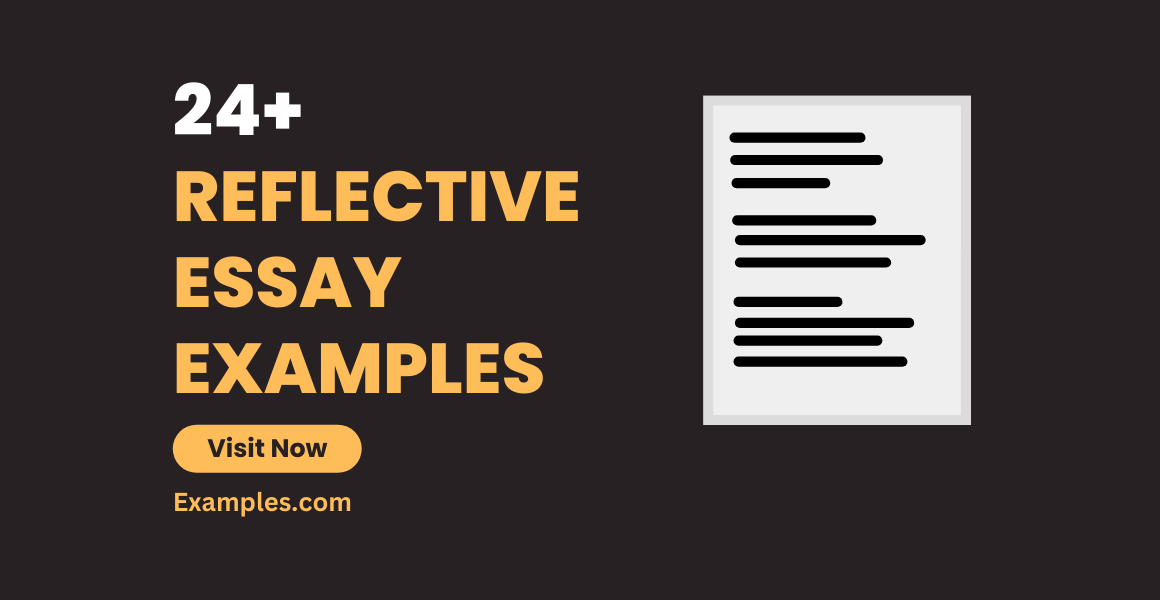
Sometimes, it is our experiences that startled and challenged our own voyage that strengthens and improves us to be the best versions of ourselves. If your life experience greatly moved you, there is a certain essay that allows you to compose your own endeavor. In this article, read through because we will be discussing the fundamentals of writing a reflective essay.
They say that being wise is better than being knowledgeable. Wisdom is acquired through reflection of one’s experience as well as of the environment. The more we reflect the more we become aware of ourselves. We become mindful of our existence as well as the meaning of life and all the things that surround us. Here we present different formats of essays like essays in doc .
Reflective Essay Outline Template

- Google Docs
Size: 188 KB
Reflective Essay About Life Experience
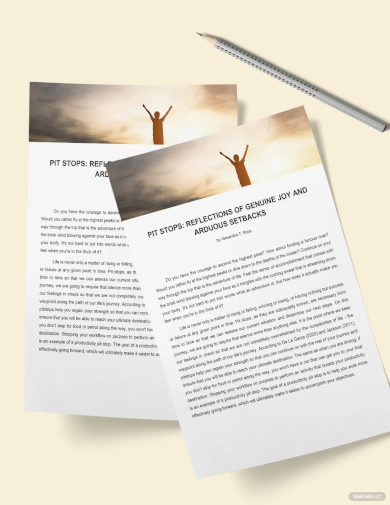
- Apple Pages
Size: 142 KB
Reflective Essay Template
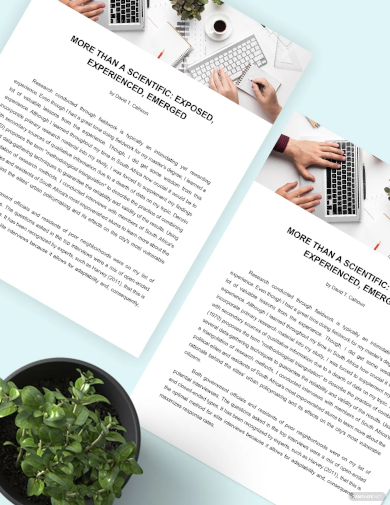
Size: 237 KB
Self Reflective Essay Template
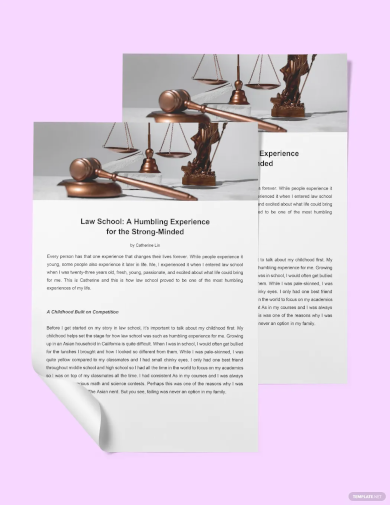
Size: 114 KB

Personal Reflective Essay Template
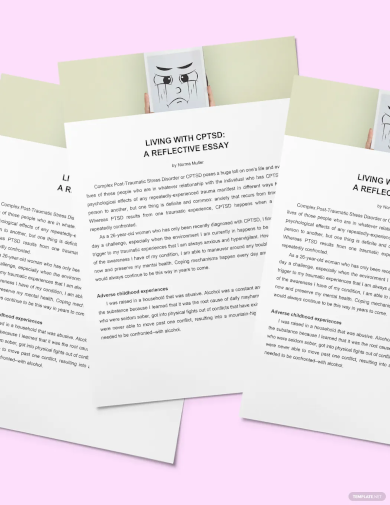
Size: 126 KB
Personal Reflective Sample
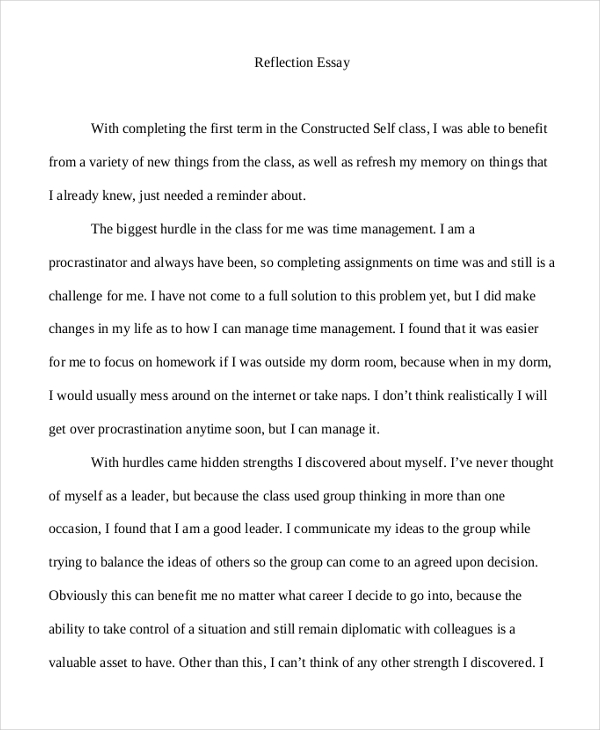
High School Essay

- PDFReflective Essay Example Reflective Essay Example Reflective Essay Example
Size: 102 KB
Reflective Essay Outline
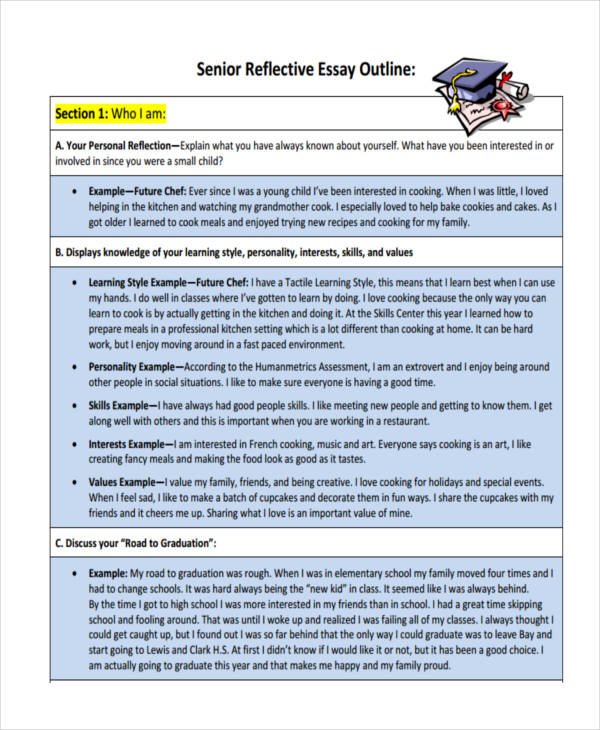
Size: 247 KB
Student Reflective Example
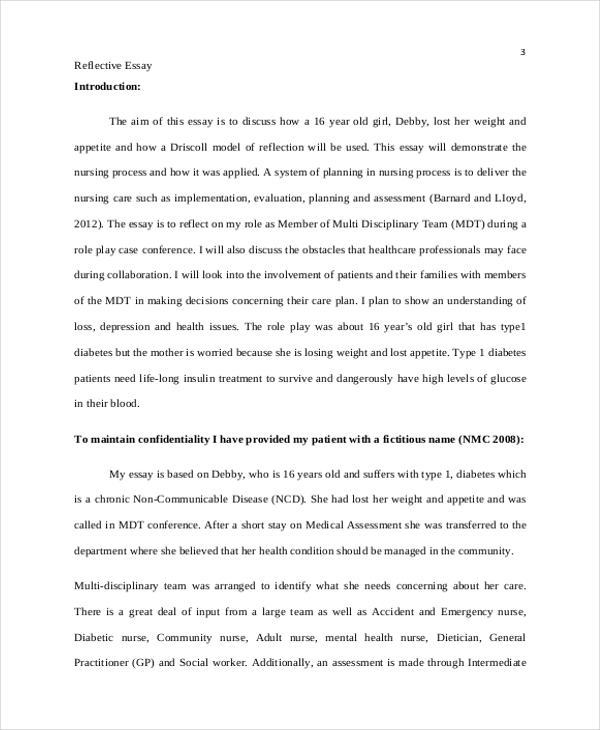
Size: 42 KB
Communication Reflective
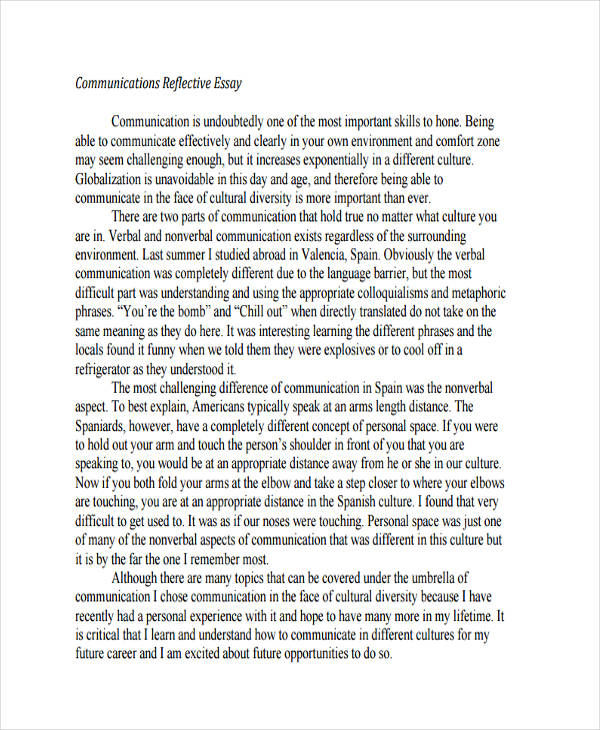
Size: 66 KB
What Is a Reflective Essay?
A reflective essay is a written piece of literature that focuses on presenting and narrating a person’s experience and how it becomes an instrument towards a change of perception in life.
It is a way for a writer to share an important event in his/her life and how it affected him/her so that others may learn something from it. Reflective writing root on life-changing events. The writer shares a specific experience, provides a narration of the incident including the material elements. It offers a realization so that others who may have had the same experience can draw out a shared mutual lesson from it.
How to Write a Reflective Essay
To write a reflective short essay , you need to have the right disposition as well as the momentum. Remember that you are not just writing to say something but to share an important lesson in life.
1. Think of an important event. What you will be writing on your reflective essay is something that is rooted in your own personal experience or encounter of something. Think deep and concentrate. You may also see personal essay examples & samples.
2. Introduce your topic. In your introduction, write the concrete event or experience that you want to share. Pattern it in a story form.
3. Develop your point. Write the main content of your essay with at least three to five paragraphs supporting your main topic.
Final Reflective Essay
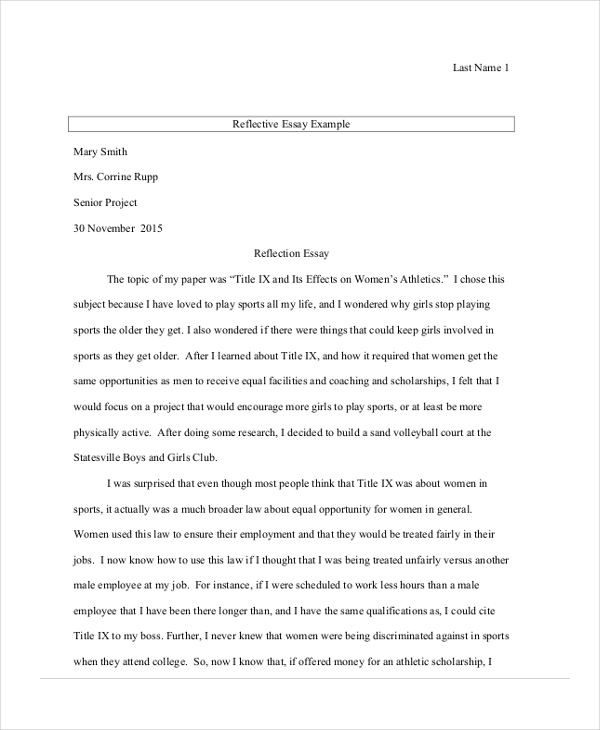
Size: 49 KB
Internship Reflective Essay
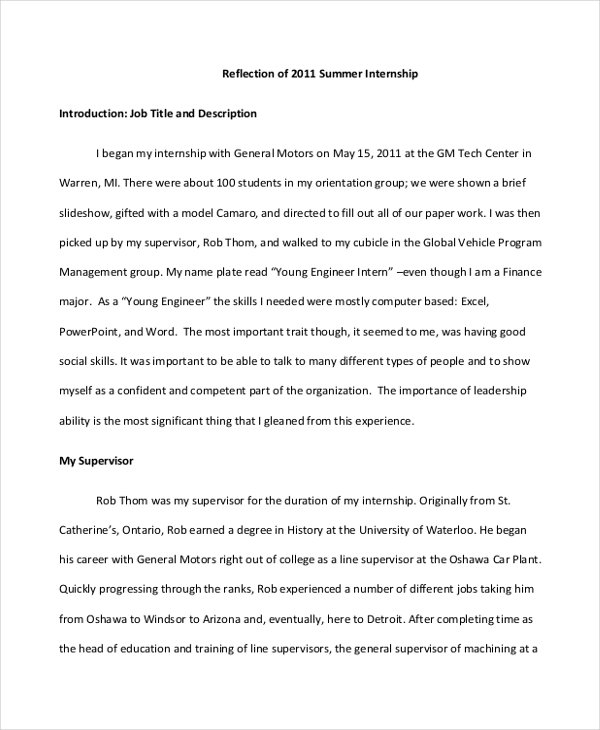
Size: 285 KB
Leadership Reflective Example
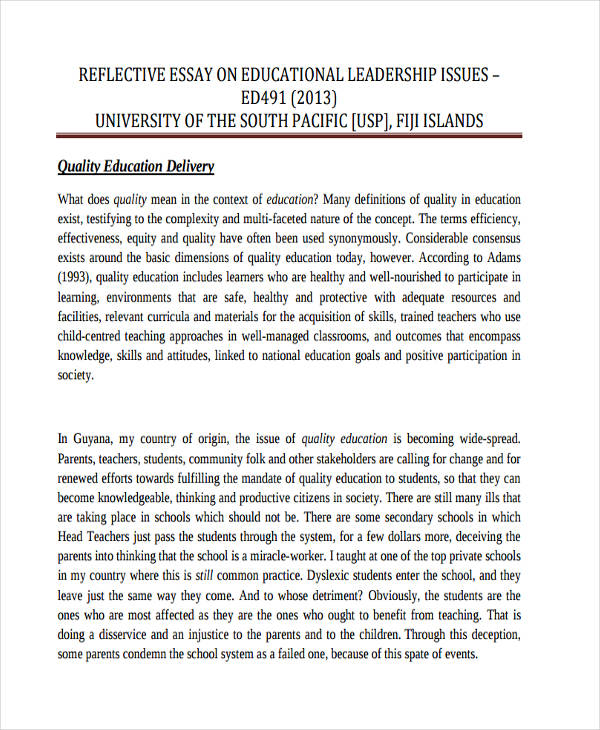
Size: 634 KB
Nursing Reflective Essay
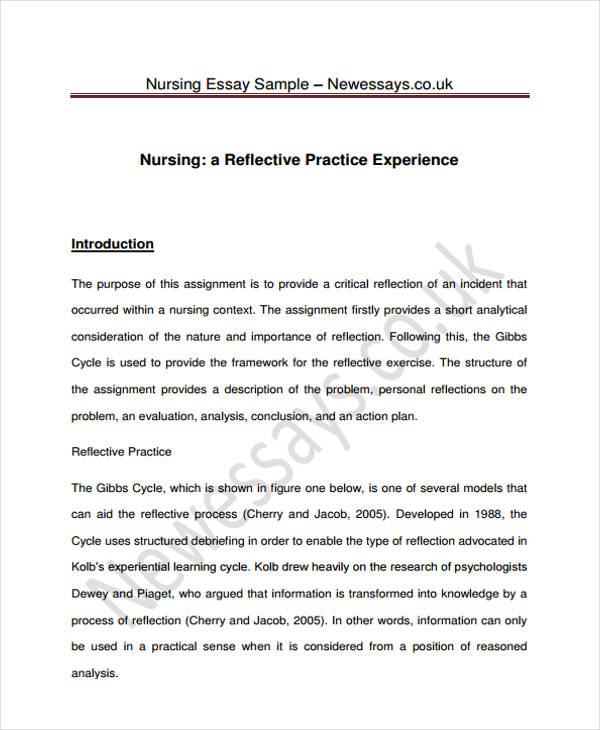
Size: 331 KB
Research Reflective Example
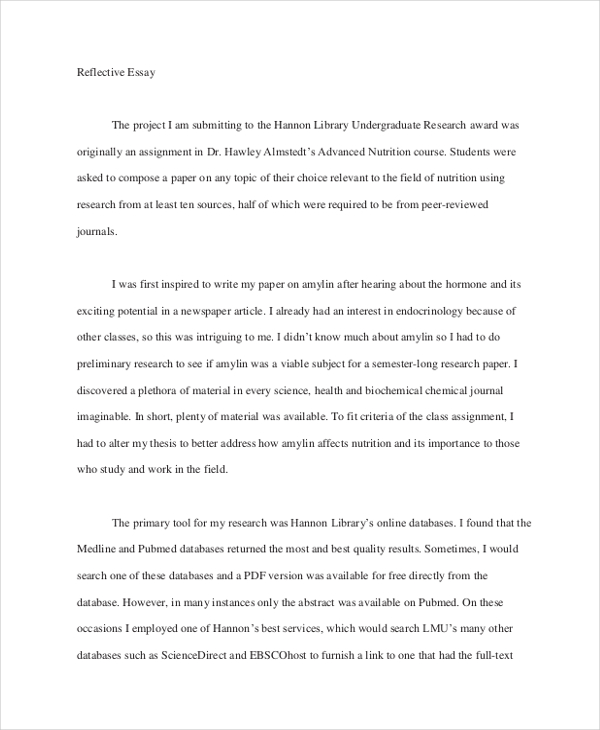
Size: 155 KB
Tips on Writing a Reflective Essay
Writing a reflective essay is not persuasive writing where you have to convince your readers to accept your opinion. You simply have to share an experience.
1. Write a draft. Do not jump hastily onto formal writing . Write a draft where you can create a bulleted list of the things that you want to share.
2. Think logically. When presenting a story, do it in a chronological manner so that your readers can understand the plot. Do this as well when presenting your ideas.
3. Create a summary. Use a summary writing to briefly state your insights and to give your final thoughts of the topic.
Importance of a Reflective Essay
In this era that we currently live in, personal reflection can be considered a thing of the past. Because of the gradual change and development of the things around us, we find it difficult to pause and reflect on the things that happen to our lives. You may also see academic essay examples .
The importance of writing an essay is to present to us the things that we rarely encounter in our day-to-day activities. In this time when material things are all that mattered, we have become unappreciative of the abstract things like love, compassion, and mercy. We cannot learn these things from those electronic gadgets that keep us busy.
How to Start a Reflective Essay Correctly
As mentioned above, a reflective essay presents and narrates the experience of a writer and how it changes the way he/she perceives life. In a simpler sense, it talks about how the author reflected on a certain adventure. As an essayist, since it’s you who bears the story and lessons, you are the one who is responsible for expressing it.
Just like any other composition, it’s your introduction that catches the attention of the reader. Thus, in order for your essay to be fully read, it is important to start your essay remarkably. If you find writing an introduction for your reflective essay challenging, don’t worry, you’re not alone. In this section, we are going to slowly tackle the ways to compose a compelling introduction.
1. Being catchy is the key.
In writing your reflective essay, you must start with something that would captivate the readers right away. Since the purpose of the introduction is to grab some attention, you may include some unique and interesting facts or beliefs. In this part, showcase your creativity by adding an introduction that is written in a bizarre manner and not those that depict cliché experience. You may also utilize a highly moving quotation or a dialogue that would also be appropriate for your reader.
2. Write the thesis statement in one sentence.
A thesis statement refers to the sentence that carries the topic being discussed in the whole essay. Therefore, it bears the central idea in which your essay revolves around. In writing your own essay, construct this statement in a clear and concise sentence. In this way, the reader will have a better grasp of your topic and would be clearly oriented on what you want to convey. In most cases, thesis statements are written at the end of the introduction.
3. Stick to the first person POV.
Remembering that this essay is subjective and depends on the author’s interpretation, it is important to use the first person point of view. By using this POV, it would be easier for you to convey your thoughts and opinions, and it would engage you to the readers like you’re telling a story in person. The first person involves the pronouns I , me , my , and mine .
4. Keep it brief.
When it comes to writing your own essay, you must perceive what your readers feel or see in reading your composition. Always put into mind that readers also have their own time to spend, and without a mark in the writing industry, people won’t invest much time on reading your essay. Thus, it is important to keep your composition concise. You can utilize a paragraph of five to ten sentences in your introduction. Using this number of sentences, you must already express a complete and clear thought of an essay that is worth reading.
Reflective Essay Example
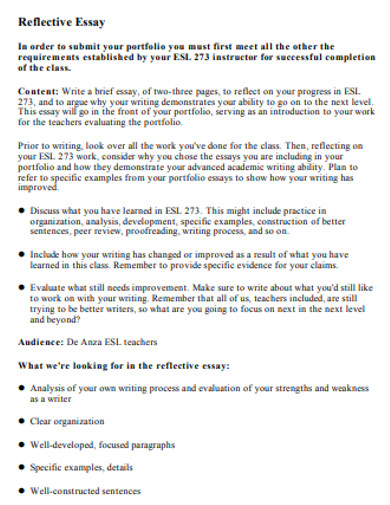
Size: 73 KB
Reflective Essay Assessment
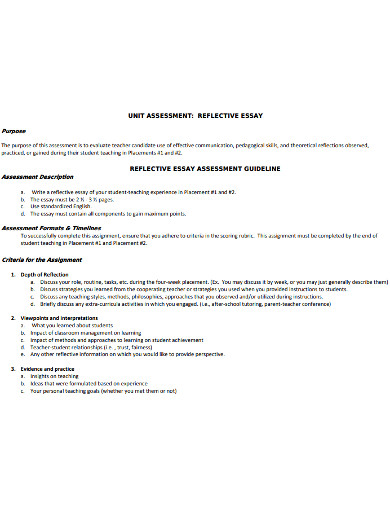
Size: 99 KB
Reflective Essay Format
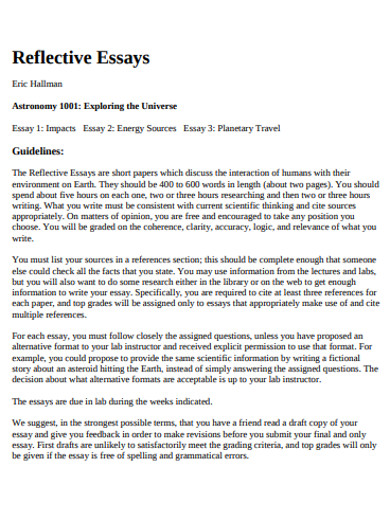
Size: 278 KB
Basic Reflective Essay
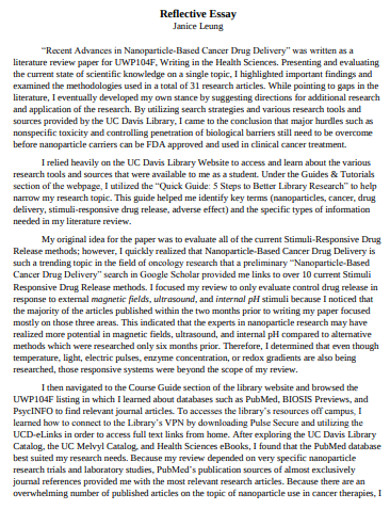
Size: 81 KB
Reflective Final Essay
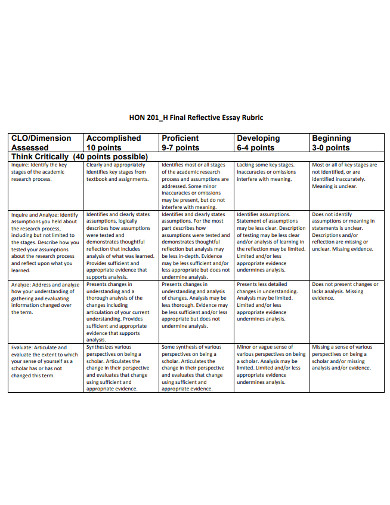
Size: 85 KB
Sample Reflective Essay
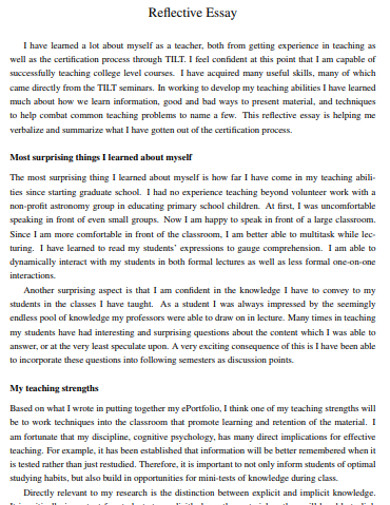
Size: 38 KB
Simple Reflective Essay Example
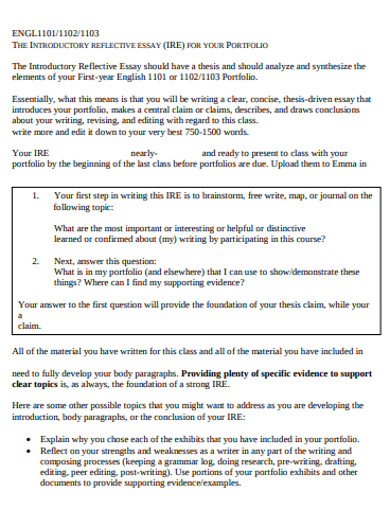
Size: 193 KB
Standard Reflective Essay
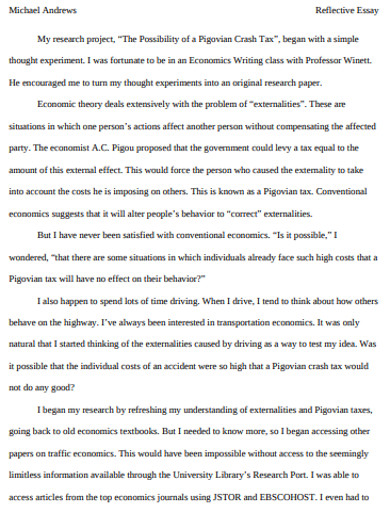
Professional Reflective Essay
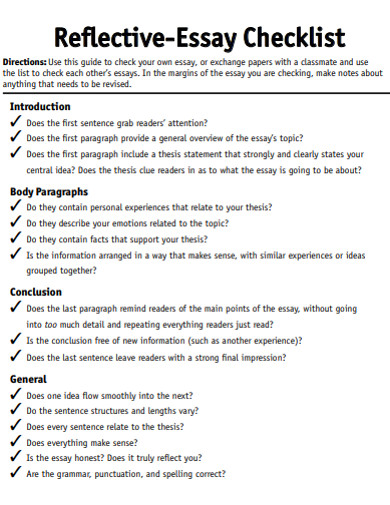
Size: 264 KB
Sample Reflective Essay in PDF
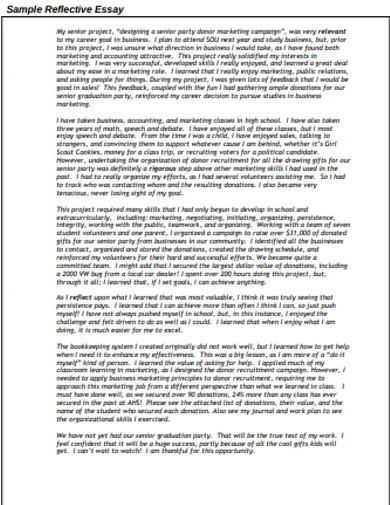
Size: 26 KB
Text prompt
- Instructive
- Professional
Write a Reflective Essay on your most meaningful learning experience.
Create a Reflective Essay about a time when you showed leadership.
The official IELTS by IDP app is here! Download it today.
- Candidate Login
- Branch Login
- IELTS on Computer
- Paper Based IELTS
- One Skill Retake (OSR)
- Why take IELTS
- IELTS for Study
- IELTS for Work
- IELTS for Migration
- IELTS Vs. TOEFL
- IELTS Vs. Duolingo
- IELTS Vs. TOEFL Vs. PTE
- IELTS Vs. TOEFL Vs. PTE Vs. Duolingo
- IELTS or PTE for Migration
- IELTS Test Dates
- IELTS Test Centres
- How do I Register?
- IELTS Test Fee
- IELTS For Academic
- IELTS For General Training
- IELTS For UKVI
- IELTS For Life Skills
- IELTS Form Filling Tips
- Choose Speaking Slot
- Reading Test Tips
- IELTS Academic Writing Task 1
- IELTS Academic Writing Task 2
- IELTS General Writing Task 1
- IELTS General Writing Task 2
- Speaking Test Tips
- Listening Test Tips
- Preparation Material
- Academic Practice Test
- General Training Practice Test
- IELTS Familiarisation Test
- Practice Test Video
- Enquiry On Results (EOR)
- Download TRF
- Frequently Asked Questions
- On paper Vs. On Computer
- Test Takers Experience
- Announcement
- IDP India CSR Policy
- IELTS Preparation Planner
- Special Requirements
- Learning Difficulties
- Visual Difficulties
- Hearing or Speaking Difficulties
- CD IELTS Test Centres
- IDP Branches
- Registration partners
- Share your Queries

Types of essays to expect in your IELTS Writing Task 2
Discover the Common Essay Types in IELTS Writing Task 2. Explore types of IELTS Essays with Questions and Samples.
In the International English Language Testing System (IELTS) Writing test Task 2, you need to write an essay with at least 250 words. This applies to both the Academic and General training modules.
But should you approach all essay questions the same way? The answer is 'no.' That's because there are different types of questions you might get. It is important to know what each question is asking you to do. Even if your grammar and vocabulary are excellent, you could still lose points if you don't understand the task. So, let’s take a closer look to make you understand all about Writing task 2 essays to help you score higher on your IELTS test .
Types of essays in IELTS Writing task 2
There are different types of essays in the IELTS Writing Task 2 , you can use these in your IELTS test preparation to score higher:
1. Opinion essay
These essays are often known as 'agree or disagree' or 'argumentative' essays and are quite common in IELTS Task 2.
The question usually starts with a statement. Afterward, you'll be asked for your own opinion about that statement. They might use these kinds of phrases:
What do you think?
Do you agree or not?
How much do you agree or disagree?
Example question: With traffic jams and pollution increasing every year in big cities, some people say that public transport should be free in big cities to help reduce these problems which are caused by cars. To what extent do you agree or disagree?
At the beginning of your essay, it's a good idea to share some background information. However, what's really important is to rephrase the words used in the question and also show where you stand on the issue. For instance:
”With the growth of middle classes around the world, ownership of motor cars has become much more common, particularly for those who reside in large urban areas. It has been argued that free public transport should be provided in these metropolises as a method to curb the amount of polluted air and traffic congestion. This essay will explain why this approach should not be undertaken for cost and mobility reasons.”
Regarding your body paragraphs, it's crucial to focus on a single main idea that you elaborate on and expand. You can achieve this by providing more details about a specific point, offering an example, discussing a result, or even acknowledging an opposing viewpoint.
Discussion essay
In discussion essays, you're required to talk about both sides of an argument. Typically, you'll also be asked for your own opinion. The simplest way to tackle this kind of IELTS Task 2 question is to select one perspective to support and another to oppose.
Example question:
Some people say that children should learn a foreign language when they are in kindergarten, but others feel that it is better for children to do this when they are teenagers. Discuss both of these views and give your own opinion.
The key concept to grasp in a task like this is that your response should have three components:
Discuss both of these perspectives (1st and 2nd part)
Present your own opinion (3rd part)
In your introduction, it's essential to address both of these perspectives, and indicating your stance can also be an effective approach. For instance:
“ Given that the world has become more globalised, the need to be able to use foreign languages has increased. As a result, there are those who believe that a child’s kindergarten years should be when another language is introduced, while the opposing view is that it is ideal to wait for when a youngster reaches adolescence. This essay will reflect on both of these viewpoints before concluding with why the infancy argument is more valid.”
When you 'discuss both of these perspectives' in your body paragraphs, remember to refrain from mentioning your personal viewpoint. This helps prevent any confusion between your own thoughts and the opinions of others.
Two-part questions
In IELTS Writing Task 2 , you might get two-part questions. These questions require you to address two different aspects or viewpoints related to a specific topic or issue. It's crucial to understand how to approach and structure your response to effectively address both parts of the question and provide a well-rounded answer.
Typically, two-part questions will ask you to:
Discuss both sides: You will be expected to present arguments or perspectives from different angles. This involves examining the pros and cons, advantages and disadvantages, or contrasting viewpoints on the given topic.
Give your opinion: In addition to discussing both sides, you will also need to express your own opinion or position on the matter. This means you should clearly state whether you agree or disagree with the topic and provide reasons for your stance.
To approach these questions successfully, follow these steps:
Introduction: Begin by introducing the topic and paraphrasing the question. Make it clear that you will discuss both sides and express your opinion.
Body Paragraphs: Dedicate one paragraph to each side of the argument. Present the arguments, evidence, or examples supporting each perspective. Avoid revealing your opinion in these paragraphs.
Conclusion: Summarise the main points from both sides of the argument and restate your opinion. Your conclusion should offer a clear and concise summary of your position.
Remember to use appropriate transition words to guide the reader through your essay and maintain a logical flow between paragraphs. Additionally, ensure that your essay is well-organised and that you provide adequate support for your arguments. Practicing with sample two-part questions can help you become more proficient in handling this type of task in the IELTS Writing test .
These days, many cities have problems when they grow quickly, such as accidents and traffic jams. Why do these problems occur? How do these problems impact people who travel for work or study?
A trend in current times is the need for many workers to spend time outside of company hours on answering text and e-mail messages for their jobs. What problems does this cause for the worker? What can be done to reduce the impact of these problems?
It is becoming very common these days for students to take courses over the Internet instead of in face-to-face classrooms. Why are more students choosing this way of learning? Is this a positive or a negative development?
In this type of task, you can write a body paragraph on each of the two questions, but it is important to fully understand what your focus should be. Try to match these tasks (A, B, or C) with the type of response required:
We hope that this article has provided you with valuable insights to improve your readiness for the various essay types you may come across in the IELTS Writing test.
In your IELTS journey, remember that consistent practice, careful analysis of question prompts, and effective time management are key elements to achieving success. So, keep practicing, stay focused, and approach each essay task with confidence to reach your desired IELTS score.
If you want to know more about the IELTS test , you can get in touch with your nearest IDP IELTS test centre. Our team of IELTS experts will help you with your queries.
Read more insightful articles:
Prepare for IELTS writing task 2
Advantage and disadvantage IELTS essay questions
IELTS writing task 2 strong introduction and conclusion
IELTS band 9 essays
Prepare IELTS general writing task 2
Tips to paraphrase in IELTS writing test
Grammar mistakes to avoid in IELTS writing test
Book my test
Share this article
Helpful resources.
Vocabulary for family, travel, and work to score high in your IELTS
Should you memorise answers in your IELTS test?
6 best apps to help you prepare for your IELTS test
Minimum IELTS score required for USA universities 2024
How to book your IELTS test online on the IDP IELTS website?
Study Nursing in Australia
MBBS in Australia for Indian Students
Medical Test for Canada Student Visa
Cost of Living in Canada for International Students
Most affordable universities in the USA
Global Gateway Towers, Tower-B, 5th Floor, Sikanderpur Ghosi, Sector-26, M.G. Road, Gurugram -122002 Haryana, India
- About IDP IELTS India
- IDP IELTS offices in India
- About IDP India
- IELTS Result
- Additional TRF
- Enquiry on Results
- Transfer & Cancellation
- Live Webinar
- CD IELTS FAQ's
- IELTS Preparation Videos
- IELTS Test Practice Material
- Free IELTS Support Tools
Copyright 2024
IELTS India
- Disclaimer - India
- Privacy policy - India
- Terms - India
River in an Ocean: Essays on Translation
This page is available to subscribers. Click here to sign in or get access .

Most of the collections of translation essays I’ve come across, including those that were key to my development as a translator—such as The Craft of Translation , edited by John Biguenet and Rainer Schulte—are centered around Western conventions. I was intrigued by Nuzhat Abbas’s vision of this new anthology as “a small vessel, an improvised container for critical and creative questions, for contemplation, for decolonial, antiracist, feminist, queer, and trans dissonance, refusal and rebellion, for care and community.” I questioned whether I should be writing this review, as I was on unfamiliar turf, only recognizing one of the contributors’ names—someone I personally knew through her work as the editor of Modern Poetry in Translation —but felt a bit more at ease upon reading the name of my publisher at Seagull Books, Naveen Kishore, in the acknowledgments section of the anthology. Indeed, it was Naveen who brought me halfway around the globe to meet with the students at the Seagull School of Publishing in Kolkata—a life-changing experience for me, who had never visited this part of the world.
Drawing on eleven feminist voices whose origins lie in such disparate geographies that include the Middle East, South and Southeast Asia, and East Africa, this anthology is a product of unsettled times, which, as Abbas states, include “the shifting conditions of an ongoing global pandemic, environmental catastrophes, growing fascism, and conflicts large and small, alongside the uncountable dead, the disabled, and the orphaned.” The contributors, broadly addressing why they translate, are a diverse mix of emerging and experienced translators working in an array of languages, including Arabic, Gujarati, Indonesian, Persian, Rukiga, Tamil, and Urdu. The backgrounds of the contributors are equally diverse, both among themselves and within themselves, such as Rwandan-born Lisa Ndejuru, who grew up in Germany and moved to Canada as a teen, and Suneela Mubayi, born in New York to a Jewish American mother and a Hindu Kashmiri father, then raised in both India and the United States.
The structure of each essay is as different from the others as each contributor. “The Meaning of a Song,” by Kenyan-born, Ugandan-raised Otoniya J. Okot Bitek, consists of a series of unsent letters written to her deceased poet-father and includes pictures from the family archives. “Elegiac Moods,” by Canadian Rahat Kurd, descended from a line of Kashmiri women, contains seven letters addressed to the late Kashmiri American poet and translator Agha Shahid Ali. Khairani Barokka’s “Apa Kabar, Penerjemah? How Are You, Translator?” alternates between Indonesian and its English translation. Saudi Arabian–born Nora Alkharashi’s “Translating Courageously” is framed around her work translating Haitian American Edwidge Danticat’s work into Arabic.
I was particularly drawn to the lyrical essays in this collection. For example, Palestinian-born Yasmine Haj’s “Rast” organizes her wisdom-infused essay into poetic prose segments about various aspects of translation. In the first section, titled “On Music,” Haj equates translation with survival:
A human’s first task is to translate. As infants, we breathe air and immediately translate. To survive, we translate. In different tones, an infant articulates hunger, distress, and fatigue. In turn, their caregivers experiment, juggle interpretations, understand, translate.
In Haj’s “On Landscape,” she discusses whether landscape might have been “the first shaper of how we translate,” describing how eons ago, a supercontinent that included today’s South America and Africa was torn apart by the effects of currents, creating what is now called the Atlantic Ocean. Integrating decolonial discourse, she muses: “If they hadn’t been separated, would translation have been needed to translate one to the other? Never mind colonization and the division of the two continents into Dutch, English, French, Italian, Portuguese . . .” Later in the essay, Haj evocatively describes the process of translating silence, making use of an astonishing but apt simile: “silence, too, is an ancient act of translation, musical in essence, magnificent in power. It amalgamates centuries of rhythm like black absorbs all colour. . . . Acts of translation must absorb before they can sing.”
In this anthology, deeply personal information serves to frame the concept of translation, such as Suneela Mubayi’s “The Temple Whore of Language.” Mubayi admits, almost with tongue in cheek, that the reason she became a translator was to avoid writing. She goes on to give a more serious answer to the question by equating translation with “un-settlement,” referencing her nonbinary sexuality—“I put the trans back into translation”—and her mixed ancestry. Humorously stating that “obviously, all translators need not be nonbinary,” she makes the case that her sexuality and mixed heritage might make her a more sensitive translator, asserting: “I exist on the margins of various opposing elements—masculine and feminine, white and non-white, and of languages and spaces that are both culturally hegemonic and non-hegemonic.” Indeed, there can be power in contradiction.
Abbas has compiled a unique anthology that attempts to make sense of personal and political trauma and offers the possibilities of a new approach to translation not based on Eurocentric translation theories. Seen through a feminist, decolonial lens, translation can be understood as un-settlement, as landscape, as memory, as self-discovery and even survival, but, most importantly, as a path that can lead to collective healing.
Nancy Naomi Carlson Walden University
More Reviews

XENIA, etc. Anthony Caleshu
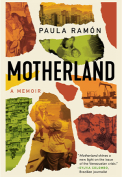
Motherland: A Memoir Paula Ramón. Trans. Julia Sanches & Jennifer Shuye
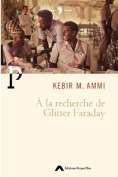
À la recherche de Glitter Faraday Kebir M. Ammi
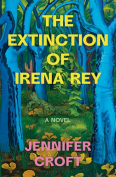
The Extinction of Irena Rey Jennifer Croft
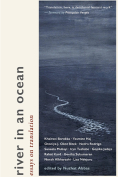
River in an Ocean: Essays on Translation Ed. Nuzhat Abbas
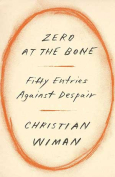
Zero at the Bone: Fifty Entries against Despair Christian Wiman
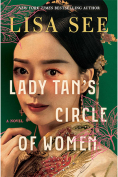
Lady Tan’s Circle of Women Lisa See
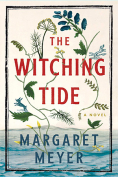
The Witching Tide Margaret Meyer
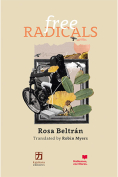
Free Radicals Rosa Beltrán. Trans. Robin Myers
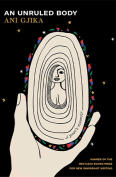
An Unruled Body Ani Gjika
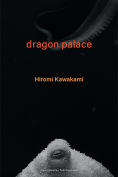
Dragon Palace Hiromi Kawakami. Trans. Ted Goossen
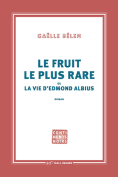
Le fruit le plus rare ou la vie d’Edmond Albius Gaëlle Bélem
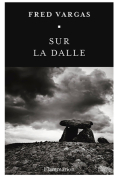
Sur la dalle Fred Vargas
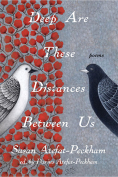
Deep Are These Distances Between Us Susan Atefat-Peckham. Ed. Darius Atefat-Peckham
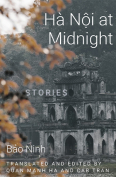
Hà Nội at Midnight Bảo Ninh. Trans. Quan Manh Ha & Cab Tran
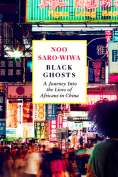
Black Ghosts: A Journey into the Lives of Africans in China Noo Saro-Wiwa
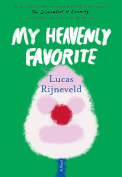
My Heavenly Favorite Lucas Rijneveld. Trans. Michele Hutchison
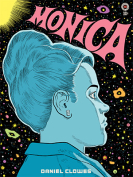
Monica Daniel Clowes
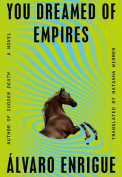
You Dreamed of Empires Álvaro Enrigue. Trans. Natasha Wimmer
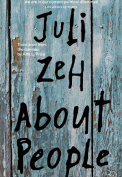
About People Juli Zeh. Trans. Alta L. Price

The Road to the City Natalia Ginzburg. Trans. Gini Alhadeff
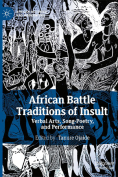
African Battle Traditions of Insult: Verbal Arts, Song-Poetry, and Performance Ed. Tanure Ojaide
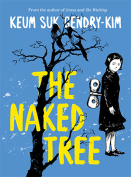
The Naked Tree Keum Suk Gendry-Kim. Trans. Janet Hong
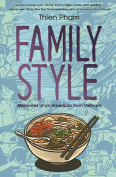
Family Style: Memories of an American from Vietnam Thien Pham
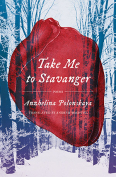
Take Me to Stavanger Anzhelina Polonskaya. Trans. Andrew Wachtel
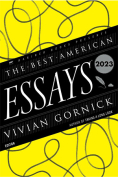
The Best American Essays 2023 Ed. Vivian Gornick & Robert Atwan
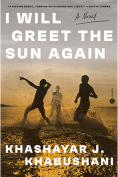
I Will Greet the Sun Again Khashayar J. Khabushani
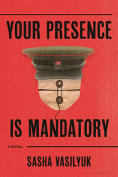
Your Presence Is Mandatory Sasha Vasilyuk
E-newsletter, join the mailing list.
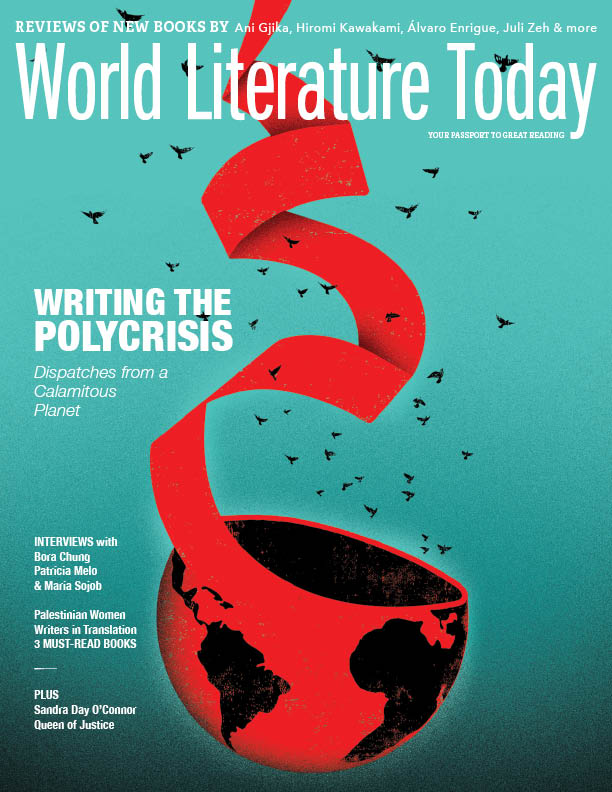
With a cover illustration by Edel Rodriguez, “Writing the Polycrisis” headlines the March/April 2024 issue of World Literature Today , showcasing contributions by nine writers, mainly from the Global South. Additional highlights include interviews, creative nonfiction, booklists, essays, and more! Plus a book review section brimming with the latest must-reads also enliven the issue, making it your latest passport to the best new reading from around the world.
Purchase this Issue »
Table of Contents
Writing the polycrisis: dispatches from a calamitous planet, in every issue, creative nonfiction, book reviews.


The lights of Warsaw, Poland (foreground) and Copenhagen, Denmark (top) from the International Space Station. Courtesy Thomas Pesquet/ESA
To take care of the Earth, humans must recognise that we are both a part of the animal kingdom and its dominant power
by Hugh Desmond + BIO
For aeons, life has fundamentally reorganised Earth. This process began roughly 2 billion years ago, when a tiny form of microbial algae, cyanobacteria, chanced on a way to live off sunlight and became so numerous that its toxic waste products caused a mass extinction. The survivors were forced to adapt to a gas that we now call ‘oxygen’. Today, one species that descended from those survivors, Homo sapiens, may be causing another mass extinction by expropriating massive amounts of Earth’s biological resources. In our short time on this planet, we have transformed plants, animals and vast tracts of habitable land. Our waste products have taken on a geological scale. Like tiny oxygen-producing microbes more than 2 billion years ago, life is once again fundamentally reorganising Earth.
However, unlike our unicellular ancestors, we are ethically conflicted about our looming fate. How much more should we grow as a species? Do we have an obligation to leave future generations with a biosphere that is as rich and diverse as the one we inherited? How should we distribute the associated costs between poor and rich nations, between producers and consumers, and between institutions and individuals? These are important, pressing issues. Beneath many of these questions lies a more fundamental ethical quandary: what should we do about our ability to so easily dominate other species and the environment? It is a problem that has become urgent. Should we disavow our dominance and attempt to minimise it? Or should we embrace our powers to alter Earth and its inhabitants?
Perhaps we shouldn’t do either.
O nce upon a time, when human dominance was still relatively new, humanity rushed to embrace it. In the first book of Genesis, God says:
Let us make man in our image, after our likeness: and let them have dominion over the fish of the sea, and over the fowl of the air, and over the cattle, and over all the earth, and over every creeping thing that creepeth upon the earth.
This early narrative of our superiority is a declaration: humans have the capabilities to control other species, and this is natural and good.
In representing humans as distinct creations, with their place in nature partially defined by their hunting or control of other animals, the Hebrew creation myth is not entirely different from many other creation myths across the world. For the Iroquoian-speaking Seneca peoples of North America, the Sky Woman taught a young boy how to hunt; for the Yao, from the Bantu peoples of Malawi and Mozambique, the Chameleon (under instruction from the creator god Mulungu) allowed humans to learn to make fire and hunt. One can imagine why these stories took hold. For our Bronze Age relatives more than 3,500 years ago, the dangers posed by nonhuman species were real and acutely felt. In those times, achieving some degree of dominance over nonhuman nature was seen as a gift. Today, hunting, gathering and farming have become industrial operations. Once so crucial to our way of life on Earth, they no longer collectively define us. But it is not only our ways of life that have radically shifted.
Today, it is impossible to believe we are privileged creatures literally created by divine powers or spiritual forces. We know too much. As the theory of evolution tells us: go back far enough, and our ancestors were not ‘human’ but merely human- like . In fact, many of the traits we once thought made us unique have shown up in other species. Other animals can problem-solve creatively, communicate using symbolic language, become indignant when treated unfairly, and mourn the dead. These evolutionary discoveries have profound implications for the stories our species tells itself. Instead of being divine creations, we are part of a sprawling family of life, replete with family resemblances. This narrative implies that, rather than dominating other species, we should care for them like family members.
The egalitarian narrative selectively frames the scientific facts and skirts difficult moral questions
And so, the story of moral superiority in Genesis gives way to a different moral tale from science. This is an egalitarian narrative teaching us that humans are just another species, with a duty to fight our tendency to dominate Earth and its inhabitants. The narrative goes something like this:
Human beings are a part of the animal kingdom, not apart from it. The separation of ‘us’ from ‘them’ creates a false picture and is responsible for much suffering. It is part of the in-group/out-group mentality that leads to human oppression of the weak by the strong as in ethnic, religious, political, and social conflicts. Let us open our hearts to two-way relationships with other animals, each giving and receiving. This brings pure and uncomplicated joy.
The behavioural scientists Marc Bekoff and Jane Goodall wrote that in 1999, in Why Dogs Hump and Bees Get Depressed . But just as the Genesis story travelled far and wide, the egalitarian narrative has spread far beyond the realms of science. It inspires the names of animal rights organisations (eg, Animal Equality) and their mission statements (‘PETA opposes speciesism, a human-supremacist worldview’). It drives legislation, which has moved towards ever-increasing protection of nonhumans from humans. And it induces a general moral ethos of guilt about humans acting against other species, whether that concerns the shame of eating meat or air travel (what the Swedish call flygskam or ‘flight shame’).
The egalitarian narrative has become the definitive narrative for our times in the Anthropocene. It seems to tick the boxes of being secular, science-based and morally responsible. However, when we look closer, the narrative selectively frames the scientific facts and skirts difficult moral questions. Its blind spot lies in representing human dominance as an optional trait we can suppress, as long as we are moral enough.
To move forward, we must find a way to come clean with our dominance, while also caring for other species. This may seem like a tall order, but backgrounding it, as the egalitarian narrative currently does, has done little to positively inspire widespread behaviour changes.
H ow effective has the egalitarian narrative really been at changing our behaviour? In Animal Liberation (1975), Peter Singer laments that ‘most human beings are speciesists’ partially because of their enthusiastic carnivory. In the late 20th century, as the animal liberation movement grew, a rejection of meat-eating became one of the ethical priorities of the egalitarian narrative. How have our habits fared since the views of Singer and other egalitarian thinkers began spreading?
The truth is that the animal liberation movement has not moved the needle much, if at all. Humans continue to eat meat on a massive scale, even in countries where inhabitants are wealthy and comfortable enough to have satisfactory substitutes for meat. People in the United States, Australia and Argentina are big meat-eaters, consuming more than 100 kg per person per year, and these numbers are roughly as big today as they were in 1970 . In Europe, the average person eats around 70 kg of meat per year, which is a slight increase from 1970. No matter how one calculates average meat consumption in developed countries, there is simply no evidence of a decrease. There is no evidence even of a downward trend.
Should we be more patient, and persist in educating the public about animal egalitarianism? Some studies suggest reasons for optimism: meat consumption in student cafeterias drops by about a quarter after students follow a course on animal ethics. However, if one looks more closely at those studies, the ethics courses did not eliminate meat consumption. They only reduced it during the semester, with unknown impact on longer-term eating habits. Did the courses persuade the students of the realities of animal suffering, or simply reduce their consumption through ‘meat-shaming’?
Consider another area of systematic animal suffering: scientific research. In the 1980s, organisations such as PETA cast light on some disturbing scientific practices, such as severing the spinal nerves of macaque monkeys, who were then allowed to chew on their own limbs (since they could feel no pain). Regulations are much stricter now, and credit is due both to animal rights organisations and the egalitarian narrative. But how fundamentally have we changed our use of laboratory animals?
We might believe in ‘two-way relationships with other animals’, but only when we deem it feasible
In 2005 , an estimated 115 million animals were used worldwide for scientific research. Ten years later, that number was suspected to have risen by two-thirds, to an estimated 192 million animals. Even in countries with the strictest animal welfare legislation, use of animals was up 5 per cent over the same period. Methods of killing and using laboratory animals are more humane today, but we still kill and use animals as never before.
Should we ban animal testing? The problem is that ‘model organisms’ – zebrafish, chicken, sheep, pigs and nonhuman primates – remain methodologically necessary. As uncomfortable as it is to admit, experiments on some of these organisms, particularly primates, apparently allow ‘unparalleled insight’ for researchers. For some interventions, like the development of a new moisturising cream, a ban would be relatively inconsequential. But what about a new chemotherapy? Or a new surgical technique? If we were to ban animal testing, one of two things would need to happen. Either we would have to test new medical interventions directly on humans, and periodically cause a handful of human deaths, or we would have to abandon risky new medical interventions altogether, risking the possibility of even more human deaths.
Neither is desirable. In fact, medical researchers who have carried out risky interventions on humans without prior testing on animals can be criminally prosecuted (and some have already received prison sentences ). And so, we choose to continue animal testing on a massive scale. We might believe in what Bekoff and Goodall described as ‘two-way relationships with other animals’, but only when we deem it feasible.
It is important not to generalise too much here: people differ greatly on how much they will go out of their way to minimise animal suffering. A growing minority avoids eating meat, and concerned scientists continually search for new substitutes for living organisms, such as digital or organoid models. However, we all draw a line somewhere. When push comes to shove, and reality brutally forces us to choose between nonhuman and human lives – or even between nonhuman lives and small improvements in human health – we tend choose the latter, time and again.
Meat consumption and animal testing illustrate the ways that our dominance is pervasive, inescapable. It is so complete that, like the air we breathe, we may not be aware of it. The choices our urbanised environments normalise presuppose dominance. Those of us who eat meat buy it from supermarkets in forms that have no visual resemblance to the animals it came from. It doesn’t ‘feel like’ we’re killing an animal, but that’s only because specialised humans do the killing for us. We also expect our food and clothing to be reasonably priced, not realising that maintaining cheap prices depends on the industrial appropriation of landscapes that would have otherwise supported diverse ecosystems. When we buy medicines, we fully expect them to be safe for human use, failing to acknowledge (or realise) the many animals that needed to die to ensure that safety. And the list goes on: we expect to inhabit spacious and warm homes, get to work by train or car, and generally have the services of schools, hospitals and restaurants close by. Many of the standards of living we take for granted today – even those we might see as basic rights – presuppose our ecological domination of Earth. We don’t realise that this, too, is space that has been appropriated by one species to the detriment of others.
Our behaviour falls woefully short of the ideals of the egalitarian narrative. This alone may seem like cause for despondency and despair. However, the problems for this narrative go deeper. Indeed, our dominance has become entirely normalised – it’s invisible. It is also inevitable. There is no way we can even avoid exhibiting dominance.
I n any two-way relationship with other animals, we are vastly more powerful. We are the ones who make decisions, and nonhuman animals are the ones who undergo our decisions. Though animals may inadvertently influence human culture, they don’t systematically set schemes in motion to control us. Consider breeding. There is no dog that gets up in the morning and dreams about controlling how humans reproduce to create a kinder, more dog-friendly human. Similarly, humans take ownership over animals as companions, not the other way around. Animals can befriend humans, but companion animals undergo the decisions of their human owners.
Antagonistic relations are even more asymmetrical: humans will sometimes attempt to exterminate an entire species they deem a ‘pest’. Individual humans can be killed by many other animals, from mosquitos to rhinos, but these species don’t set out to kill humans by engineering entire environments. Humans, however, will organise and take systematic measures to make an environment as inhospitable as possible to ‘pests’, whether that is a ‘weed’ growing in a garden or an undesired animal that has entered a farm or an ecosystem humans want to protect.
Compared with other animals, we have god-like powers. We are demiurges who can turn our desires into reality and mould other species to suit our purposes. Just think of our control over dogs. Across millennia, we sculpted the Eurasian wolf into thousands of anatomical varieties, each tailored to specific human needs. And today, we have the power to reshape the lives of millions of other animals, using gene-manipulation techniques like CRISPR. Our agency – our freedom of action, our capacity for choice and deliberation – is of a vastly higher degree.
Every environmentally conscious decision we make for animal wellbeing is paternalistic
We weren’t always like this. Our ancestors such as Homo erectus started out, around 2 million years ago, as marginal predators in East Africa. Over time, they managed to control fire, use rudimentary stone tools and migrate to new environments in Asia. These are extraordinary feats, but their inventiveness did not weigh particularly strongly in the struggle for survival. Being smart was still not a great ecological advantage over running fast, having sharp claws or a powerful bite.
Soon, the inventiveness of hominins began to snowball. The more our ancestors learned about how the world worked, and the better tools and know-how they developed, the more they flourished. As a result, populations grew, allowing more freedom for experimentation and reflection. We began engaging in sustained symbolic communication around 40,000 to 50,000 years ago; we figured out how to domesticate animals and grains around 10,000 years ago; and we learned how to harness fire to power machines about 250 years ago. The great trends in human history have been driven by new ways of exploiting the environment and turning these resources to ends of our choosing. There is no turning back.
Today, through environmental laws, nature reserves, sanctuaries and endangered-species lists, we have begun to deliberately curtail some of our domination of the environment. But even when attempting to protect animals from the detrimental effects of human dominance, we cannot help but exert our agency and dominance in other ways. Every environmentally conscious decision we make for animal wellbeing is paternalistic. Constructs such as nature reserves or endangered species lists are the result of human agency: humans deciding which nonhumans need protection and how they should be protected. We decide what is best for animals based on our ideas, not their ideas. We rule over other living creatures, sometimes benevolently, sometimes not so benevolently – this is one point where contemporary science would not judge the Bible entirely wrong.
It may be jarring to point to human dominance in this way. Pointing to what is always raises the question of what ought to be. Should we not hasten to add that our dominance is a bad thing?
W e rarely set out to dominate other animals for the sake of domination itself. Instead, our all-consuming concern is to improve human life: to treat diseases, fight poverty, raise our children as best we can, help our neighbours, and seek economic prosperity. Animal suffering is, unfortunately, a byproduct of our struggle to better our lives. Our flourishing has come at the expense of other species.
The core problem with the egalitarian narrative is that it imagines a world where there is no conflict of interest between humans and nonhumans. That world is nonexistent, at least for the foreseeable future. Space on this Earth is finite, and making room for our own cities and farms has meant displacing and destroying ecosystems. Energy must come from somewhere, and assuming we will never evolve the ability to photosynthesise, we will need to kill living organisms for our sustenance. And much biomedical knowledge can only be achieved by experimenting on living systems: sometimes we really do need to experiment on animals if we want to spare human test subjects from the worst risks. Yet the egalitarian narrative doesn’t acknowledge the reality of these tradeoffs. It creates the expectation that we can one day live in perfect equality with other species and avoid subordinating animal interests to human interests. The egalitarian narrative, focused on the idea that we are connected to all living creatures, often ignores the inevitability of conflicts and competing interests that arise. Often, the result of this perspective is guilt, shame and despondence.
The progress narrative illustrates why we continue to cling so dearly to the egalitarian narrative
Instead, we need a worldview that acknowledges that humans, for the foreseeable future, will always be the powerful party, deciding what needs to be done. We need a narrative that brings together two seemingly contradictory facts. The first is that we are part of the animal kingdom: our evolutionary ancestors were nonhumans; we care about other animals; we feel their pain; and we can feel a deep attachment to nature as our home, the place we came from, and where we belong. The second is that we are not just any part of the animal kingdom: we dominate other animals, in so many ways; we domesticate them, carry out tests on them, take them as companions or work animals; we clear out ecosystems for farmland or houses. So we care about animals in some ways, but we also compete with them in other ways.
The egalitarian narrative highlights the first fact, but papers over the second. It says that we are part of nature, but seeks to obscure how humans continue to dominate other species. Yet we should proceed carefully, because history – particularly the history of ‘progress’ during the 20th century – points to the dangers in highlighting the second fact but papering over the first. The progress narrative illustrates why we continue to cling so dearly to the egalitarian narrative, despite its shortcomings.
O nly a few generations ago, biologists and intellectuals of all colours adhered to the notion of progress . Society had to progress, and all the different ideologies – liberalism, communism, fascism – had different strategies for achieving this. Likewise, biologists looked at the history of life, and saw it as a slow onward march towards biological progress, with the human species at the apex of evolution.
It is hard to overemphasise how influential this ‘progress narrative’ was. In 1946, the first director general of UNESCO, Julian Huxley, wrote the following preparatory text :
There is one other general implication of the fact of evolutionary progress, which Unesco must take into account – the importance of quality as against quantity … [T]here are over a million separate species of plants and animals as against one in the human sector; but this single species Man is the only one in which evolution has produced the full flowering of mind and spirit.
Nowhere in Huxley’s reasoning does one find an explicit endorsement of animal cruelty. His reasoning was that an overarching theory of evolutionary progress would give a scientific basis to sound policy initiatives so as to ensure moral progress. Nonetheless, there is something unsettling in the way the interests of one species are simply, without further ado, posited as weightier than the interests of millions of others.
Nazi ideologues interpreted ‘breeding’ to mean the extermination of the ‘worst specimens’
Part of the backstory here is that Huxley was also a eugenicist. As a movement, eugenics was very much taken with ideas of biological or evolutionary progress. In the eugenicist vision, the main obstacle to progress was that the ‘best specimens’ of humanity were producing fewer offspring than the ‘worst specimens’, largely because of developments like modern medicine and the welfare state. This needed to be stopped to avoid catastrophic genetic consequences down the line. Hence, according to the eugenicist rationale, it was necessary to apply the same systematic breeding methods that humans had applied to other animals. In the UK, eugenics had a predominantly classist bent (the ‘best’ specimens tended to be upper-class men and women) and, in the US, a predominantly racist bent (the ‘best’ tended to be white).
Eugenicist logic was radicalised by Nazi ideologues, who interpreted ‘breeding’ to mean not just forcible sterilisation but the extermination of the ‘worst specimens’. This is where the progress narrative led us and, ever since, the perceived connotations of this perspective have been strongly anti-egalitarian. These perceptions are what underlies statements such as that of PETA: ‘Bigotry begins when categories such as race, age, gender, disability, sexual orientation, or species are used to justify discrimination.’ In this view, opposition to animal cruelty and exploitation is just one part of the wider opposition to bigotry – in fact, PETA once ran an exhibition called Holocaust on Your Plate that compared the meat industry with the Holocaust.
Our attachment to the egalitarian narrative, then, is not just motivated by scientific considerations, it is also a reaction to the moral catastrophes of the 20th century. We cling to this narrative – despite the yawning gap with reality – because we fear where the alternative might lead us. Perhaps we should consider a different story, one about human success ?
B ased on metrics such as population size, geographic range and ecological dominance, our species is unique compared with other large-bodied animals. Scientists sometimes describe us as an ecological ‘success’. This is a very different way of narrating the science. It acknowledges human dominance, but in a morally positive way: we must have done something right to be where we are today. Our ‘success’ is a reason for pride. We can be proud of having grappled with environmental uncertainty and unpredictability, including drought and deadly diseases. We can be proud of building communities, caring for the next generation. We can be proud of our flourishing.
Microscopic water bears (tardigrades) or Argentine ants have found their niches across the globe, and are ‘successful’ in their own ways, but no other primates have chanced upon the combination of prosociality, culture and problem-solving that allowed us to spread far from our equatorial origins. We are an evolutionary ‘success story’.
However, success can sow the seeds for future failure. By exploiting ecosystems, we are simply hastening our downfall. Like Icarus, we fly too close to the sun; or perhaps we are more like Prometheus, and have stolen fire from the gods, who will punish us once they find out. As our populations grow, requiring more and more energy, we increasingly resemble an elephant in a porcelain shop, and need to tread ever more nimbly. Our ‘success’, in other words, cannot be a justification for unbridled exploitation.
It’s never the orangutan who decides how they should be best protected but human ecologists and conservationists
The success narrative offers a way of understanding our place on Earth in a different way. Humans are an offshoot of the family of life, but owe their success to that family and have a duty of care for that family. This is the kind of familial care that motivated the egalitarian view – the view that we are all animals, part of a wider evolutionary family. However, through the success narrative, the care for animals adopts a more explicitly paternalistic shape. We are not the equals of animals, nor should we pretend to be, but that does not at all imply a justification of rapacious exploitation. Instead, think of the asymmetrical relationship between a human adult and child. Think of the care and sacrifice that an adult brings to that relationship. We need a similar type of care for animals when our interests conflict with theirs.
In fact, we cannot avoid being paternalistic towards animals. If a tiger at the zoo needs a more varied environment, it’s never the tiger who will take the matter in hand and make the requisite purchases to ensure a high-quality habitat. The zookeeper will decide for the tiger. If an endangered orangutan needs protection, it is never the orangutan who decides how they should be best protected; it is human ecologists and conservationists. Animals can sometimes communicate their direct needs to us (food, danger, companionship) but, as a rule, they cannot share their fundamental interests, let alone enter into a political debate to shape collective decision-making. It must be humans who take the lead. This means that the moral weight lies in a duty to take this leadership seriously: we must observe and reason what contributes to the wellbeing of other animals, and make decisions that anticipate their needs.
In the 20th century, horrors were wrought on human society by forms of inegalitarian thinking that placed humans (and certain groups of humans, in particular) at the apex of progress. Since then, ethical and political thinking in the West has strongly shifted towards egalitarianism, including towards nonhuman animals, and talk of human superiority is eschewed as a first step towards justifying animal cruelty – or worse. Yet, many inegalitarian behaviours towards animals remain, inducing in many a mixture of guilt and despondence, which in turn does not inspire the majority with a positive message to change their behaviour.
At some collective tipping point, will we tire of pretending that humans and nonhumans are moral equals? Failing to acknowledge this reality sets unrealistic expectations and does not hold water: we dominate animals in so many ways, even when we try not to. When that tipping point will come is impossible to say. However, we need an ethically plausible alternative narrative before we ever give up on the egalitarian one, a narrative that is more honest about human dominance, and also gives guidance on our moral responsibilities towards other species. Thinking about humans as a successful species holds some promise, especially when success is combined with an egalitarian view of the family of life.
Humans are part of the animal kingdom, and we have also come to dominate that kingdom. Denying either reality will prevent us from ever taking full responsibility to care for it.

Stories and literature
Her blazing world
Margaret Cavendish’s boldness and bravery set 17th-century society alight, but is she a feminist poster-girl for our times?
Francesca Peacock

Mental health
The last great stigma
Workers with mental illness experience discrimination that would be unthinkable for other health issues. Can this change?
Pernille Yilmam
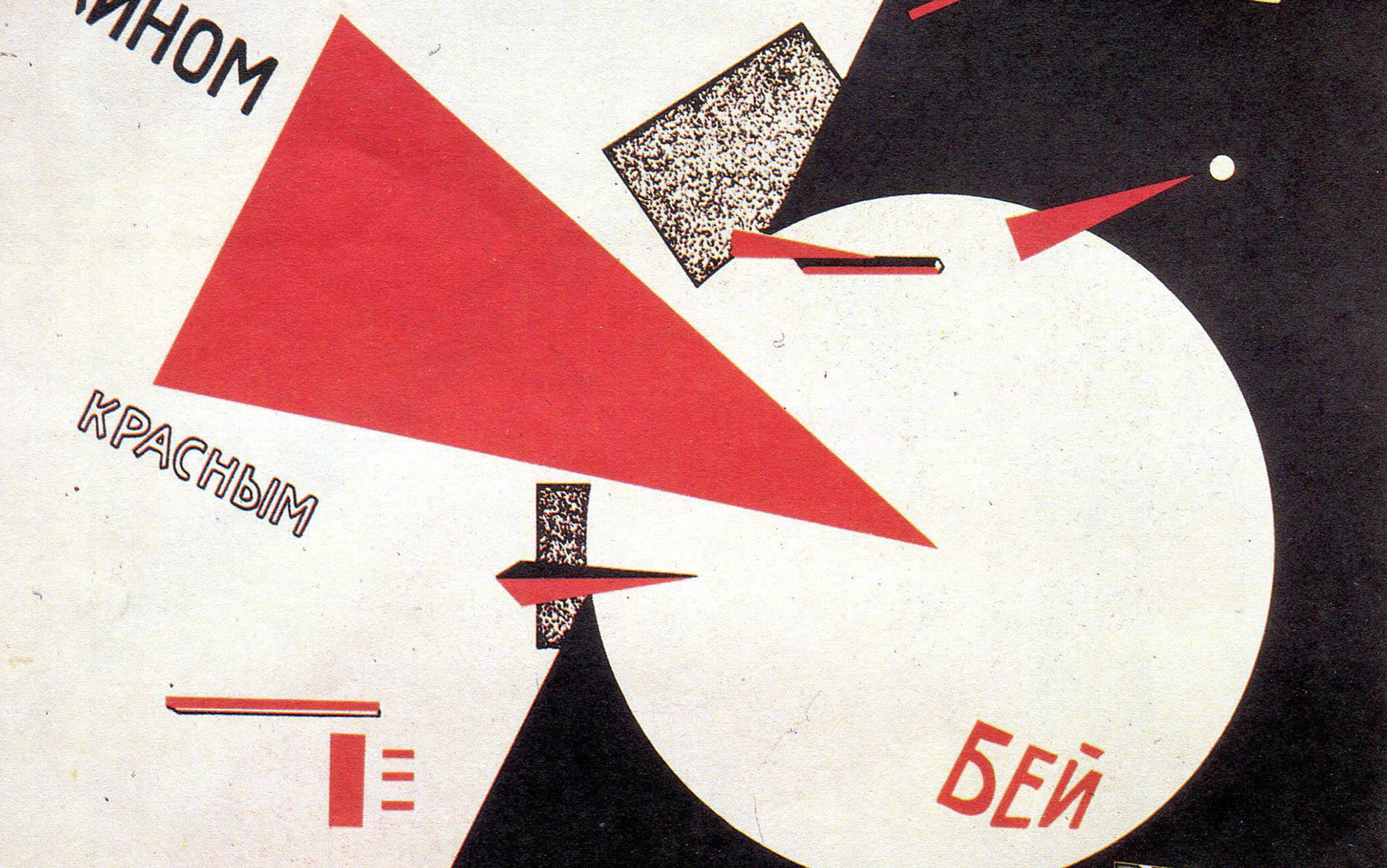
Quantum theory
Quantum dialectics
When quantum mechanics posed a threat to the Marxist doctrine of materialism, communist physicists sought to reconcile the two
Jim Baggott

Folk music was never green
Don’t be swayed by the sound of environmental protest: these songs were first sung in the voice of the cutter, not the tree
Richard Smyth

Nations and empires
A United States of Europe
A free and unified Europe was first imagined by Italian radicals in the 19th century. Could we yet see their dream made real?
Fernanda Gallo

On Jewish revenge
What might a people, subjected to unspeakable historical suffering, think about the ethics of vengeance once in power?
Shachar Pinsker
- If you are writing in a new discipline, you should always make sure to ask about conventions and expectations for introductions, just as you would for any other aspect of the essay. For example, while it may be acceptable to write a two-paragraph (or longer) introduction for your papers in some courses, instructors in other disciplines, such as those in some Government courses, may expect a shorter introduction that includes a preview of the argument that will follow.
- In some disciplines (Government, Economics, and others), it’s common to offer an overview in the introduction of what points you will make in your essay. In other disciplines, you will not be expected to provide this overview in your introduction.
- Avoid writing a very general opening sentence. While it may be true that “Since the dawn of time, people have been telling love stories,” it won’t help you explain what’s interesting about your topic.
- Avoid writing a “funnel” introduction in which you begin with a very broad statement about a topic and move to a narrow statement about that topic. Broad generalizations about a topic will not add to your readers’ understanding of your specific essay topic.
- Avoid beginning with a dictionary definition of a term or concept you will be writing about. If the concept is complicated or unfamiliar to your readers, you will need to define it in detail later in your essay. If it’s not complicated, you can assume your readers already know the definition.
- Avoid offering too much detail in your introduction that a reader could better understand later in the paper.
- picture_as_pdf Introductions

- Prospective Cadets
- Faculty & Staff
Cadets earn Pershing medallion in recognition of top reflective essays through MX400

WEST POINT, N.Y. – Through the Simon Center for the Professional Military Ethic (SCPME), MX400 is the superintendent’s capstone course for all U.S. Military Academy Firsties with an emphasis on an officer’s duty to provide moral leadership. The course challenges cadets to become commissioned leaders of character who demonstrate virtue, honor, patriotism and subordination to civilian authority.
A key part of the course has the cadets look both to the past and future on their own character development experiences as part of the West Point Leader Development System (WPLDS), while studying the enduring and emerging ethical challenges of the profession they are about to enter.
One of the major requirements in the course is the Gen. John J. Pershing Reflective Essay. Each year, every Firstie cadet is required to be graded on a signature writing event, which allows them to be a candidate for the Gen. John J. Pershing Writing Award.
Established and endowed in 2006 by retired Lt. Gen. John Cushman, USMA Class of 1944, the Pershing Writing Award is meant to encourage cadets to reflect on their experiences at West Point and gain a better understanding for how the institution has helped them prepare for the profession of arms and to strengthen their resolve to serve the nation honorably as a commissioned officer.
Cushman, who commanded 2nd Brigade, 101st Airborne Division in Vietnam, wanted to inspire cadets with an award that emphasized West Point’s significance in their development. Then, it was naming the award after one of the academy’s most influential leaders, Pershing, and accentuate his legacy and contributions to the Army and nation, highlighted by commanding the Allied Expeditionary Force during World War I.
This year, more than 1,000 cadets from the USMA Class of 2024 authored an essay with the MX400 instructors identifying the top essays from their sections and then a selection committee reviewing all the submissions. Once the dust was settled and the choices were made, three members of the class were chosen as top essay award recipients and three were chosen for honorable mention.
The cadet authors were celebrated during the Gen. Pershing Award ceremony on May 22 at the Thayer Award Room where they received their medallions and certificates. The three cadets who earned honorable mention were Class of 2024 Cadets Reagan Warren, Christian Dionisio and Carlo Octoman.
The top three cadets who earn medallions were Class of 2024 Cadet Maximilian Hodsden (first place, gold), Class of 2024 Cadet Brennan McAlister (second place, silver) and Class of 2024 Cadet Maximillian Renfro (third place, bronze).
One of the key elements of the Pershing Essay within the role of writing in the Army profession is encouraging deep reflection and critical thinking, which is essential for effective leadership. There are other elements that are taken into account from learning from failure and reflecting on personal experiences and lessons that may guide them as an officer.
The second-place awardee, McAlister, wrote an essay about how the death of his father at age 16 calloused him emotionally. McAlister spoke about how his father was a good man, but human flaws caused his downward spiral.
“The situation shocked me, and I became, quite frankly, a (jerk) to people and didn’t help those who were struggling since my efforts to save my dad never worked,” McAlister explained. “However, candid feedback from senior officers and growing a relationship with God through the Catholic Church helped me learn humility.”
McAlister said it was “super cool” to be recognized as an awardee, and while being grateful in receiving the second-place award, he does question his worthiness.
“I don’t think I’m cut from the same cloth as (Pershing) despite me winning second place,” he stated.
During the closing remarks, it was mentioned that the essay encourages cadets to embrace the values of Duty, Honor, Country in their future careers, however, it can come with re-evaluating that commitment due to life’s circumstances as was the case for Hodsden.
Hodsden was surprised to discover he had won the 2024 Pershing Writing Essay award from the perspective that he felt he had “so much left to say on my essay and was only able to convey only a fraction of what I wanted to.”
Hodsden said his essay reflected on going through a personal low in his life during the first semester of his Firstie year.
“After my older sister, and best friend, Hailey Hodsden, died during the summer before my Firstie year due to Army negligence, I grew resentful of my chosen profession and became miserable in all aspects of my life,” said the Dripping Springs, Texas, native. “I struggled a great deal with depression and what I should do next. Continuing the course toward graduating and becoming a commissioned Army officer felt like betraying her memory, but leaving West Point would have betrayed the support and expectations of my family, friends and mentors.
“I wasn’t able to commit to being great and instead accepted being a terrible cadet, barely surviving instead of thriving,” he added. “Only through the help of my friends and loved ones and a gradual realization that protecting what was entrusted to me was I able to overcome my struggle and commit to my dreams again.”
His sister, who was a USMA Class of 2021 graduate, was killed while serving in Germany when a Stryker vehicle she was traveling in was struck by a civilian truck on the Autobahn.
As a Chinese major who graduated and commissioned as a second lieutenant in the Air Defense Artillery branch on May 25, Hodsden said this reflective essay allowed him to analyze his struggles and moral conflicts that had shaped his life and burgeoning career up to this point.
“For the longest time, I kept all of these dark thoughts and low moments to myself, but being able to share them and how I overcame them was very constructive,” Hodsden said. “Knowing how I got to such a low and how I recovered not only helps me for future challenges in my life but also can help others who may find themselves in a similar situation in the future.”
During his first three years at West Point, Hodsden said he absolutely loved it at the academy and thought the “challenges and lessons all felt worthwhile and enjoyable.” Of course, that changed in a moment of tragedy, but it also made him learn more about himself.
“My final year felt like a nightmare and yet I was able to march forward and graduate with my class regardless,” he articulated. “This makes me realize that I may be more resilient than I first thought. No matter what the Army throws at me, I know nothing can ever be worse than how I felt this past semester, and I can take the lessons learned into my Army career.”
As the first-place recipient of the Pershing Essay Award, Hodsden feels honored and privileged to not only earn first place but to be associated with Gen. Pershing.
“Truthfully, I believe every cadet does and should believe that they may be the next Pershing,” Hodsden explained. “With this honor, I will have a consistent reminder of morality within the profession.”
When discussing who were the most influential people on his journey at West Point and guided him toward becoming an Army officer, two people came to mind but only one person was at the forefront of his thinking – his sister, 1st Lt. Hailey Hodsden.
“I couldn’t have made it through this place without her, and I truly loved her more than anyone else in the entire world,” he asserted through his emotions. “She motivated, inspired and led me and countless others, and she was the best officer this Army has ever seen. Because of her, I was the happiest Plebe and the saddest Firstie to ever be at West Point.
“Secondly, I would like to thank my MX400 instructor, retired Lt. Col. David Jones,” he added. “His instruction and example helped guide me and countless other cadets toward the essence of officership and professionalism. I truly feel ready for becoming an officer due to his class.”
Also awarded during the ceremony was the General of the Army Omar N. Bradley Award for Character, which is given to a cadet with a top 10 weighted composite of institutional variables relating to cadet character. The award recognizes one cadet each year who exemplifies the compassion, concern for others and leadership traits possessed by Bradley. This year’s recipient was Class of 2024 Cadet Jaques Schold, who through the words of Gen. Bradley’s late wife, Esther Dora Bradley, in her Last Will and Testament that her hope is the award may shape “another Bradley” to serve and to lead our nation in the future.
- Ask Yale Library
- My Account (Orbis)
- Special Collections
- Scan and Deliver
- Borrow Direct
- Interlibrary Loan
- Bass Media Equipment
- Bass 8:30am - 10pm
- Lewis Walpole 10am - 4:45pm
- Beinecke 10am - 4:30pm; Exhibitions open until 7pm
- Lillian Goldman Law 8am - 6pm
- Classics 9am - 5pm
- Marx Science and Social Science 8:30am - 8pm
- Cushing/Whitney Medical 7:30am - 12am
- Sterling 8:30am - 8pm
- Divinity 8:30am - 5pm
- Yale Center for British Art
- Gilmore Music 8:30am - 8pm
- Film Archive 10am - 5pm
- Haas Family Arts 8:30am - 5pm
- Manuscripts and Archives 10am - 4:30pm
Yale Library
- Quicksearch
- Archives at Yale
- Digital Collections
- FirstSearch (WorldCat)
- BorrowDirect
- Purchase Request
- Course Reserves
- Using Library Collections
- Using E-resources
- Using Special Collections
- Research Consultation
- Personal Librarians
- Subject Specialists
- Accessibility Services
- Subject Guides
- Course Guides
- Copyright Basics
- Digital Humanities
- Geographic Information Systems (GIS)
- Research Data Management
- Library Workshops
- Citation Tools
- Printers and Scanners
- Places to Study
- Carrels and Lockers
- Media Equipment
- Room Reservations
- Library Access and Use
- Sterling Library Tours
- Beinecke Rare Book
- Cushing/Whitney Medical
- Gilmore Music
- Haas Family Arts
- Lewis Walpole
- Lillian Goldman Law
- Marx Science and Social Science
- Sterling Memorial
- Collection Development
- Fortunoff Video Archive
- Humanities Collections
- International Collections
- Lux: Collection Discovery
- Primary Sources
- Mission, Vision, Strategic Directions
- Diversity, Equity, Inclusion, and Accessibility
- Library News
- Exhibitions
- Staff Directory
- Working at Yale Library
- Library Prizes
12 graduates awarded library prizes for best senior essays
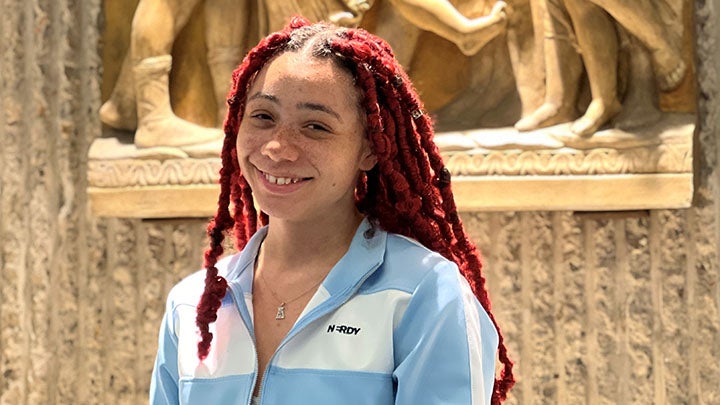
Each year, the library invites Yale College seniors to submit their senior essays for consideration to win one of three prizes for excellence: the Harvey M. Applebaum ’59 Award, the Diane Kaplan Memorial Prize, and the Yale Library Map Prize. The winners are selected by librarians or faculty members, and the prizes are funded by Beinecke Rare Book and Manuscript Library.
The prizewinners are each awarded a cash prize in the amount of $500 (honorable mention recipients receive $250), and all winners’ essays are published on EliScholar, Yale Library’s digital platform for scholarly publishing. As is the tradition, students receive their awards at their residential commencement ceremonies.
The Harvey M. Applebaum ’59 Award
The Harvey M. Applebaum ’59 Award recognizes a student whose senior essay or capstone project substantially draws on national government information or intergovernmental organization (IGO) information, including documents or data. Yale Library has been a designated federal depository library since 1859.
The Applebaum award was presented to Henry H. Carroll , Davenport College, for the essay “Ship Shaping: How Congress and Industry Influenced U.S. Naval Acquisitions from 1933—1938.” Read Henry Carroll’s essay .
Honorable mention was awarded to Nina Grigg , Benjamin Franklin College, for the essay “Surveyor: Scratching for a Wild Moon.” Read Nina Grigg’s essay .
The Diane Kaplan Memorial Prize
The Diane Kaplan Memorial Prize recognizes prizewinning students’ excellent use of research materials from the library’s diverse collections and also the high quality of their writing.
Three students received the Diane Kaplan prize this year:
Leo Egger , Trumbull College, for the essay “‘Living Its Strange Life’: A Literary Biography of Margery Latimer from the Archives in 18 Scenes.” Read Leo Egger’s essay .
AJ Laird , Benjamin Franklin College, for the essay “Whaling Logbooks: Colonial Knowledge Acquisition in the Pacific World.” Read AJ Laird’s essay and visit the related exhibit in Sterling Memorial Library exhibition corridor.
Shira Minsk , Pauli Murray College, for the essay “Steady through Time: Ella Barksdale Brown and the Perception-Based Politics of Black Women’s Racial Uplift in 20th-Century America.” Read Shira Minsk’s essay .
The Library Map Prize
The Library Map Prize recognizes students whose senior essays or projects make use of one or more maps or charts in substantive ways. Students may either create the maps or refer to maps found online or in the library’s special collections.
This year the Map Prize was awarded to two seniors:
Lisa Dong , Pierson College, for the interactive StoryMap essay “So, Where Are Your Really From?: A Digital Humanities Repository Mapping ‘Home, Identity, and Belonging’ within the Intimacies of the Fuzhounese Experience.” View Lisa Dong’s web-based essay .
Nick McGowan , Pauli Murray College, for the essay “Rebirth: Investigating Industrial Gentrification and the Land Use Policy in Chicago’s West Loop.” Read Nick McGowan’s essay .
The Department of History Prizes
The library also stewards the funds for three American History prizes, selected by faculty members in the Department of History. This year, five prizes were awarded for best senior essays.
Julia Aerin Hornstein , Ezra Stiles College, won the Howard R. Lamar Prize for the essay “Charles ‘Minnie’ Dole: The Peak of Masculinity and the Frontier of Western Snow”; AJ Laird , Benjamin Franklin College, won a David M. Potter Prize for “Whaling Logbooks: Colonial Knowledge Acquisition in the Pacific World”; Sydney Zoehrer , Silliman College, won a David Morris Potter Prize for the essay “Adobe: Material Histories at a Crossroads in Marfa, Texas; Hilary B. Griggs , Branford College, won a Walter McClintock Prize for the essay “Does a Man’s Word or a Nation’s Word Ever Become Obsolete?’: Fighting the Floodwaters on the Fort Berthold Reservation”; Teanna Hart (Sicangu Lakota), Silliman College, won a Walter McClintock Prize for the essay “Reconciliation Is Not Enough: Looking and/as Speaking Back at Portrayals of the American Indian”; and Taylor Rose won the Frederick W. Beinecke Dissertation Prize for the essay “Battle Born: Mining, Militarization, and Native Lands in the Nevada Desert, 1860–1990.”
Read more about the three Library Prizes and other Undergraduate Student Prizes. Read more about the History prizes.
- View More News

IMAGES
VIDEO
COMMENTS
Step 1: Start with a question. You should come up with an initial thesis, sometimes called a working thesis, early in the writing process. As soon as you've decided on your essay topic, you need to work out what you want to say about it—a clear thesis will give your essay direction and structure.
A thesis statement is a very common component of an essay, particularly in the humanities. It usually comprises 1 or 2 sentences in the introduction of your essay, and should clearly and concisely summarize the central points of your academic essay. A thesis is a long-form piece of academic writing, often taking more than a full semester to ...
A good thesis has two parts. It should tell what you plan to argue, and it should "telegraph" how you plan to argue—that is, what particular support for your claim is going where in your essay. Steps in Constructing a Thesis. First, analyze your primary sources. Look for tension, interest, ambiguity, controversy, and/or complication.
Thesis. Your thesis is the central claim in your essay—your main insight or idea about your source or topic. Your thesis should appear early in an academic essay, followed by a logically constructed argument that supports this central claim. A strong thesis is arguable, which means a thoughtful reader could disagree with it and therefore ...
It is a brief statement of your paper's main argument. Essentially, you are stating what you will be writing about. Organize your papers in one place. Try Paperpile. No credit card needed. Get 30 days free. You can see your thesis statement as an answer to a question. While it also contains the question, it should really give an answer to the ...
A thesis statement . . . Makes an argumentative assertion about a topic; it states the conclusions that you have reached about your topic. Makes a promise to the reader about the scope, purpose, and direction of your paper. Is focused and specific enough to be "proven" within the boundaries of your paper. Is generally located near the end ...
A thesis statement: tells the reader how you will interpret the significance of the subject matter under discussion. is a road map for the paper; in other words, it tells the reader what to expect from the rest of the paper. directly answers the question asked of you. A thesis is an interpretation of a question or subject, not the subject itself.
Composing a thesis statement does take a bit more thought than many other parts of an essay. However, because a thesis statement can contain an entire argument in just a few words, it is worth taking the extra time to compose this sentence. It can direct your research and your argument so that your essay is tight, focused, and makes readers think.
Thesis Your thesis is the central claim in your essay—your main insight or idea about your source or topic. Your thesis should appear early in an academic essay, followed by a logically constructed argument that supports this central claim. A strong thesis is arguable, which means a thoughtful reader could disagree with it and therefore needs
The thesis statement is the one sentence that encapsulates the result of your thinking, as it offers your main insight or argument in condensed form. A basic thesis statement has two main parts: Topic: What you're writing about. Angle: What your main idea is about that topic.
mer home a thesis. (If the essay is complex or long, its structure may be briefly announced or hinted at after the thesis, in a road-map or plan sentence—or even in the thesis statement itself, if you're clever enough.) 7. Stitching: words that tie together the parts of an argument, most commonly (a) by using transition (link-
How to Prepare to Write an Essay. Before you start writing your essay, you need to figure out who you're writing for (audience), what you're writing about (topic/theme), and what you're going to say (argument and thesis). This section contains links to handouts, chapters, videos and more to help you prepare to write an essay.
Explore how the introduction, body paragraphs, and conclusion parts of an essay work together. What are the 5 parts of an essay? Explore how the introduction, body paragraphs, and conclusion parts of an essay work together. Dictionary ... You can kind of think of it like a smaller part of your thesis sentence. It's the main idea that you want ...
Body—An essay includes body paragraphs, which develop the main idea (thesis or claim) of the essay. An effective body paragraph should: Work together with the other body paragraphs to create a clear, cohesive paper (clarity and coherence can be achieved through the use of transitions). Conclusion—An essay ends with a brief conclusion, which ...
An essay is a piece of writing that is written to convince someone of something or to ... adequately informed, the essay must include several important components to make it flow in a logical way. The main parts (or sections) to an essay are the intro, body, and conclusion. In a ... At the end there should be what is called a thesis statement ...
Argumentative Essay. Any time you try to persuade someone, you are doing argumentative writing - an argumentative essay can be cause and effect, persuasive, compare and contrast, etc. In an argumentative or persuasive essay, you i dentify something that you think is a problem, then propose a solution.
In some contexts, the word thesis or a cognate is used for part of a bachelor's or master's course, while dissertation is normally applied to a doctorate. ... term papers or essays. A longer paper or essay presented for completion of a 4-year bachelor's degree is sometimes called a major paper.
2. Write the thesis statement in one sentence. A thesis statement refers to the sentence that carries the topic being discussed in the whole essay. Therefore, it bears the central idea in which your essay revolves around. In writing your own essay, construct this statement in a clear and concise sentence.
Two-part questions. In IELTS Writing Task 2, you might get two-part questions. These questions require you to address two different aspects or viewpoints related to a specific topic or issue. It's crucial to understand how to approach and structure your response to effectively address both parts of the question and provide a well-rounded answer.
Toronto. Trace Press. 2023. 223 pages. Most of the collections of translation essays I've come across, including those that were key to my development as a translator—such as The Craft of Translation, edited by John Biguenet and Rainer Schulte—are centered around Western conventions.I was intrigued by Nuzhat Abbas's vision of this new anthology as "a small vessel, an improvised ...
Human beings are a part of the animal kingdom, not apart from it. The separation of 'us' from 'them' creates a false picture and is responsible for much suffering. It is part of the in-group/out-group mentality that leads to human oppression of the weak by the strong as in ethnic, religious, political, and social conflicts.
Since 2006, Oxbridge Essays has been the UK's leading paid essay-writing and dissertation service. We have helped 10,000s of undergraduate, Masters and PhD students to maximise their grades in essays, dissertations, model-exam answers, applications and other materials.
In general, your introductions should contain the following elements: When you're writing an essay, it's helpful to think about what your reader needs to know in order to follow your argument. Your introduction should include enough information so that readers can understand the context for your thesis. For example, if you are analyzing ...
The Simon Center for the Professional Military Ethic hosted the John J. Pershing Reflective Essay Award ceremony on May 22 at the Thayer Award Room. ... A key part of the course has the cadets look both to the past and future on their own character development experiences as part of the West Point Leader Development System (WPLDS), while ...
Exegetical essays on several words relating to future punishment; Names Stuart, Moses, 1780-1852 Created / Published ... Part of. Selected Digitized Books (155,909) General Collections (196,333) Library of Congress Online Catalog (1,602,178) Format. Book/Printed Material ...
The Applebaum award was presented to Henry H. Carroll, Davenport College, for the essay "Ship Shaping: How Congress and Industry Influenced U.S. Naval Acquisitions from 1933—1938." Read Henry Carroll's essay. Honorable mention was awarded to Nina Grigg, Benjamin Franklin College, for the essay "Surveyor: Scratching for a Wild Moon."
The Absolutely True Diary of a Part-time Indian by Sherman Alexie is an award-winning young adult novel that has received critical acclaim since its publication in 2007. This coming-of-age story follows the life of Junior, a 14-year-old Native American boy who leaves his impoverished reservation to attend an all-white high school.
Essays from Internet Public Library | Fourteen-year-old Junior, also known as Arnold Spirit Jr., lives on the Spokane Indian Reservation in Washington. ... Junior carves his own path, becoming a "part-time Indian" not in terms of belonging but in terms of perspective, bridging the gap between two cultures and fostering understanding ...